
RETURN UNDELIVERABLE CANADIAN ADDRESSES TO: CSPG – 150, 540 – 5th Ave SW Calgary, AB, T2P 0M2 $7.00 MAY/JUNE 2017 VOLUME 44, ISSUE 3 Canadian Publication Mail Contract – 40070050 GeoConvention & Core Conference In This Issue... Technical Abstract Sneak Peek Session Highlights Core Conference & The Western Canadian Sedimentary Basin




DIAMOND SPONSORS SAMARIUM SPONSOR




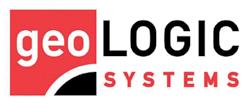
TITANIUM SPONSORS





BRONZE SPONSORS



GOLD SPONSORS

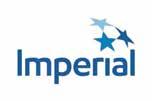





CORPORATE SUPPORTERS
Chinook Consulting Services
Belloy Petroleum Consulting
XRF Solutions Ltd
RIGSAT Communications
I H S Markitt
Bannatyne Wealth Advisory Group
Canada Brokerlink Inc.
RPS Energy Canada Ltd.
Canadian Global Exploration Forum
CMC Research Institutes, Inc.
Encana




SILVER SPONSORS PLATINUM SPONSORS




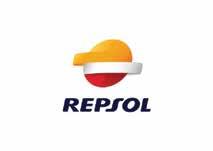





Halliburton
LXL Consulting Ltd.
MJ Systems
RS Energy Group
Schlumberger Canada Limited
Pulse Seismic Inc
Cabra Consulting Ltd.
CAPL
Earth Signal Processing Ltd.



T. Cadrin Holdings Ltd.
Saguaro Resources
Siftgrid
TAQA North Ltd.
Midwest Surveys
*As of March 31st
Navigator Resource Consulting
Synterra Technologies
Birchcliff Energy Ltd.
Baker Hughes Calgary
Roke Technologies Ltd.
McDaniel & Associates Consultants Ltd.
MEG Energy Corp.
Signature Seismic Processing Inc.
Tectonic Energy Consulting Inc.
THANK-YOU
TO ALL OF OUR SPONSORS
BOARD OF DIRECTORS 2017
CSPG OFFICE
#150, 540 - 5th Ave SW
Calgary, Alberta, Canada T2P 0M2
Tel: 403-264-5610
Web: www.cspg.org
Please visit our website for all tickets sales and event/course registrations Office hours: Monday to Friday, 8:30am to 4:00pm
The CSPG Office is Closed the 1st and 3rd Friday of every month.
OFFICE CONTACTS
Membership Inquiries
Tel: 403-264-5610
Email: membership@cspg.org
Advertising Inquiries: Emma MacPherson
Tel: 403-513-1230
Email: emma.macpherson@cspg.org
Sponsorship Opportunities: Lis Bjeld
Tel: 403-513-1235
Email: lis.bjeld@cspg.org
Conference Inquiries: Kristy Casebeer
Tel: 403-513-1233
Email: kristy.casebeer@cspg.org
Accounting Inquiries: Nancy Mosher
Tel: 403-513-1232
Email: nancy.mosher@cspg.org
Executive Director: Lis Bjeld
Tel: 403-513-1235, Email: lis.bjeld@cspg.org
EDITORS/AUTHORS
Please submit RESERVOIR articles to the CSPG office.
Submission deadline is the 23rd day of the month, two months prior to issue date. (e.g. January 23 for the March/April issue)
To publish an article, the CSPG requires digital copies of the document. Text should be in Microsoft Word format and illustrations should be in TIFF format at 300 dpi., at final size.
CSPG COORDINATING EDITOR
Emma MacPherson, Programs Coordinator, Canadian Society of Petroleum Geologists
Tel: 403-513-1230, emma.macpherson@cspg.org
The RESERVOIR is published 6 times per year by the Canadian Society of Petroleum Geologists. The purpose of the RESERVOIR is to publicize the Society’s many activities and to promote the geosciences. We look for both technical and non-technical material to publish.
The contents of this publication may not be reproduced either in part or in full without the consent of the publisher. Additional copies of the RESERVOIR are available at the CSPG office.
No official endorsement or sponsorship by the CSPG is implied for any advertisement, insert, or article that appears in the Reservoir unless otherwise noted. All submitted materials are reviewed by the editor. We reserve the right to edit all submissions, including letters to the Editor. Submissions must include your name, address, and membership number (if applicable).The material contained in this publication is intended for informational use only.
While reasonable care has been taken, authors and the CSPG make no guarantees that any of the equations, schematics, or devices discussed will perform as expected or that they will give the desired results. Some information contained herein may be inaccurate or may vary from standard measurements. The CSPG expressly disclaims any and all liability for the acts, omissions, or conduct of any third-party user of information contained in this publication. Under no circumstances shall the CSPG and its officers, directors, employees, and agents be liable for any injury, loss, damage, or expense arising in any manner whatsoever from the acts, omissions, or conduct of any third-party user.
Printed by CBN Commercial Services, Calgary, Alberta.






PRESIDENT
Mark Cooper
Sherwood Geoconsulting Inc. president@cspg.org
PAST PRESIDENT
Greg Lynch
Shell Canada Ltd. pastpresident@cspg.org
FINANCE DIRECTOR ELECT
Jim Barclay
directorfinanceelect@cspg.org
DIRECTOR
John Cody
Statoil Canada Ltd. industryrelations@cspg.org
DIRECTOR
Kevin Parks
Alberta Energy Regulator kevin.parks@aer.ca
EXECUTIVE DIRECTOR
Lis Bjeld
CSPG lis.bjeld@cspg.org





PRESIDENT ELECT
Clint Tippett presidentelect@cspg.org
FINANCE DIRECTOR
Shelley Leggitt
NAL Resources Ltd. directorfinance@cspg.org
DIRECTOR
Mark Caplan conferences@cspg.org
DIRECTOR
Alex MacNeil
Osum Oil Sands Corp. AMacNeil@osumcorp.com
DIRECTOR
Michael Webb
Suncor Energy mwebb@suncor.com
RESERVOIR ISSUE 3 • MAY/JUNE 2017 3

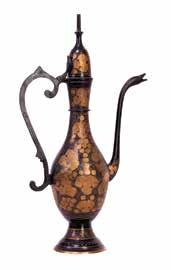
Power your upstream decision-making with customer-driven data, integrated software and services from geoLOGIC. geoSCOUT | gDC Upstream knowledge solutions
knowledge action IS USELESS AND knowledge without ACTION IS futile.
Bakr At geoLOGIC, we help turn raw data into actionable knowledge. That’s a powerful tool to leverage all your decision making, whether it’s at head office or out in the field. From comprehensive oil and gas data to mapping and analysis, we’ve got you covered. Get all the knowledge you need, all in one place with geoLOGIC. For more on our full suite of decision support tools, visit geoLOGIC.com
WITHOUT
Abu


RESERVOIR ISSUE 3 • MAY/JUNE 2017 5 TABLE OF CONTENTS FRONT COVER Virginia Falls, Northwest Territories. This spectacular vista is seen on the South Nahanni River in the Northwest Territories at the junction of the Selwyn Fold Belt and the Mackenzie Fold Belt. The river hurtles through a section of rapids known as the Sluice Box before tumbling over limestone and recessive shales of the Middle Ordovician Sunblood Formation and into the Fourth Canyon of the South Nahanni. A spire of limestone, known as Mason's Rock, survived as the falls migrated up-river and splits the flow. With a vertical drop of 96m, Virginia Falls almost doubles the 51m cascade of Niagara Falls (Horseshoe Falls). Wes Waddell MAY/JUNE 2017 – VOLUME 44, ISSUE 3 MONTHLY SPONSORS 2 MESSAGE FROM THE BOARD ............................................................................6 MESSAGE FROM THE EDITORS ........................................................................7 TALKING WITH ARCHITECTS ............................................................................9 GEOCONVENTION & CORE CONFERENCE THEME ARTICLES A History of GeoConvention 14 Three Year GeoConvention Strategy 16 GeoConvention Board ............................................................................................17 Committee Bios.......................................................................................................18 Palaeogeographic evolution of the Montney in the Western Canada Sedimentary Basin ..................................................................................................21 A Virtual Mcmurray Formation Outcrop Tour – An Evolving Tool For Characterizing Oil Sands Reservoirs And Creating Realistic Geomodels 24 Caribou: The Next Montney Oil Sweet-Spot .........................................................25 Session Highlights...................................................................................................26 Core Conference 2017: Grand Tour of the Western Canada Sedimentary Basin ............. 33 Core Conference Technical Program 35 UPCOMING EVENTS Division Talks ..........................................................................................................37 SOCIETY NEWS Medal of Merit 2016 ................................................................................................42 RJW Douglas Medal 2016 .......................................................................................44 Link Award – Best Oral Presentation 45 University Outreach 46 FROM THE ARCHIVES .........................................................................................47
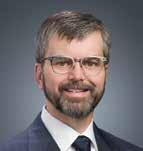
GA MESSAGE FROM KEVIN PARKS
By Kevin Parks, CSPG Director for Publications
eoConvention and Core Conference are here again. The annual gatherings are always a great time to hear new ideas, discover opportunities, and network with old friends. The informal nature of our conferences creates tremendous value for our Canadian energygeoscience community, which is why the CSPG and the GeoConvention partners put on a great show year after year. I’d like to call attention as well to another purpose of the GeoConvention and the Core Conference, which is to drive our science forward. The presentations and posters and discussions are great opportunities to test and challenge ourselves, but we need to remember that these activities are often just the first steps in the creation of new and lasting scientific knowledge. The comments and questions on the GeoConvention floor and at the AER Core Research Centre are really informal tests of peer acceptance and topicality. The presenters work very hard pulling their ideas and presentations together, and the audiences do a lot of work reading and processing the work on display. But we can’t let it end there. We need to accept the criticism of our work and make it better, learn from our peers in real time, and then take the best to the next level, which is formal publication.
CSPG offers two distinct streams to get our
science out after the conference events. One is by publication of articles in the Reservoir, and the other is by publication of peerreviewed papers in the Bulletin of Canadian Petroleum Geology.
Reservoir articles can be topical, technical, personal, and even controversial. They are relatively quick to produce. Our technical co-editors, Jason Frank and Travis Hobbs, are at your service to welcome your ideas and contributions. The benefit to you is very timely recognition and discussion of your work by your peers in the Canadian energygeoscience community.
The other route is publication of a robust technical paper or note in the Bulletin of Canadian Petroleum Geology. Our Bulletin is recognized as the permanent record of our community’s contribution to Canadian geoscience. Bulletin papers and notes take more time to prepare, but the audience is global and includes all our descendants in geoscience. That doesn’t mean things have to be perfect and final to be published, but we do insist on scientific validity, formal peer review, and editorial oversight. Technical case studies and reviews of geological units found in Tables of Formations for Canadian sedimentary basins also find a wide audience in the Bulletin. The Bulletin also accepts technical notes on new methods, ideas, and
emerging areas of study. Our editors in chief, Dr. Bernard Guest and Dr. Hairuo Qing, as well as myself, are available to answer your questions on the Bulletin process.
The barriers to publication are not as high as one may think, however. More work is done in industry, consulting, and government that is worthy of publication than we often give credit for. We also fully appreciate how commercial concerns may delay your uptake of these opportunities for formal publication. But if the contribution is novel and important, we can wait for the time to be right for you. But please don’t wait too long.
The CSPG Presidents, Editors, and Directors and Staff, including myself, will be at GeoConvention and the Core Conference this year as always. Don’t be surprised if we take a minute of your time after your talk or poster and ask you to consider publication in the Reservoir or the Bulletin. Take it as a complement from your peers and then give it some serious thought. Your work is valuable and we want to see it captured as a lasting contribution in one of our publications.
You know more than you think. I challenge you to dare to share.
Have a great GeoConvention and Core Conference 2017.
6 RESERVOIR ISSUE 3 • MAY/JUNE 2017
MESSAGE FROM THE BOARD
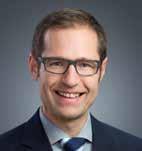
Jason Frank
Technical Editor for the CSPG Reservoir Sr. Geologist at Athabasca Oil Corporation
Jason Frank is a Professional Geologist who holds a B.Sc. and M.Sc. from the University of Alberta. He has over 16 years of experience in oil and gas including technical and leadership positions in exploration and development both on and offshore. Past experience includes Shell Canada Ltd., Burlington Resources Ltd., ConocoPhillips Canada Ltd., and Talisman Energy Inc. Jason has volunteered for the Society in the past, most recently chairing the Duvernay session at the Society’s annual convention (2014) and the Honourary Address Committee.
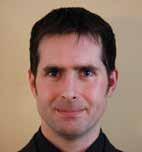
Travis Hobbs
Technical Editor for the Reservoir Professional Geologist at Encana
Travis Hobbs is an undergraduate from University of Calgary with a graduates degree from Simon Fraser University in Geology. Professionally has worked both domestically and internationally for 19 years in the Oil & Gas industry, and is currently celebrating 15 years with Encana. Industry roles have included development, exploration, management and business development. Prior to the Reservoir, Travis has held previous roles on convention committees and six years as the Chair of Continuing Education. As free time permits Travis enjoys cycling, cross-country skiing and teaching his two daughters violin.
GEOCONVENTION & CORE CONFERENCE ISSUE
Ihope that everyone is enjoying the first few weeks of spring after a long winter. With Spring comes growth and what better way to kick off this dynamic season than with some knowledge sharing at GeoConvention and the CSPG Core Conference. Firstly, a big thanks to the Convention Committees and Board Members for agreeing to provide some technical sneak peaks, highlights and a look at the dedicated people behind these conventions. A heartfelt thanks to Dustin Menger, GeoConvention Executive Director. Dustin was instrumental in working with the session chairs and committee members to generate the content of this Reservoir issue; I would like to add to his title: Honorary Reservoir Editor.
I hope this Convention themed Reservoir will spark reader’s excitement for GeoConvention and the CSPG Core Conference. We highlight just some of the exceptional sessions and offer a few teasers from what I am sure will be some very well attended technical talks.
I start this issue with a look at some of the exceptional individuals who have been working for the past year to bring the GeoConvention together. This issue’s interview in the “Talking with Architects” series is with Dr. Paul MacKay who, in
addition to his contributions to Conventions in the past, is also a longstanding volunteer for many other roles and responsibilities with the CSPG. Personally, I find the opportunities to get some perspective from these individuals one of the best parts of being an editor. I hope you enjoy reading as much as I enjoyed talking with Paul. It is people like Paul who help shape the conventions for the CSPG as you will see in the “History of GeoConvention” article and from the current GeoConvention Board’s vision and strategies for the future.
The CSPG Core Conference, organized by several individuals from ConocoPhillips, showcases some very robust plays in the WCSB that have been active during this latest downturn. A big thank you to Ketly Latos for some highlights and a sneak peak in to this year’s core displays.
Last issue of the Reservoir “Challenging Docterine”, aired some different takes on some very well studied formations, namely the Cardium and the Fort MacMurray. I would encourage readers who want to continue the healthy debate to reach out. I find the Reservoir a very good venue for this written debate and would like to continue with a series of “Challenge” and “Rebuttal”.
– Travis
RESERVOIR ISSUE 3 • MAY/JUNE 2017 7
FROM THE
MESSAGE
EDITORS
would like to thank the following 2016 sponsors:
Diamond Sponsors
AGAT Laboratories
Cambria Business Services
geoLOGIC Systems
Little Rock Printing Schlumberger of Canada
Emerald Sponsors
Chinook Consulting Services
Gold Sponsors
Belloy Petroleum Consulting
Loring Tarcore Labs Ltd.
M J Systems
Pason Systems Corp.
RBC Dominion Securities Trimble Engineering Associates Ltd.
Silver Sponsors Pro
Tournament Information
Schedule: Thursday June 22, 2017
6:00am Breakfast
7:30am Shotgun Start
12:30pm Lunch Break
4:30pm 19th hole
5:30pm Awards BBQ
Where: Elbow Springs Golf Club
Format: 2-person teams - Enter with partner of any skill level for three 9-hole matches against other teams of equitable skill level
Cost: Member’s Price - $179 +GST
Non-member’s Price - $199 +GST
Online registration and payment only.
To register, go to CSPG.org and select the following tabs: “Events,” “Sporting Events,” and “Classic Golf.” or Classic Golf on the home page. Registration limited to 64 players, please register early.
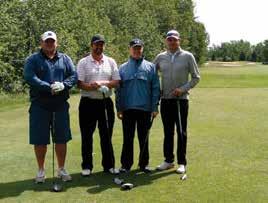
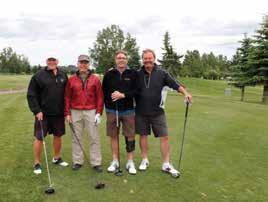
56thCLASSIC2017 56th A NNU AL C SPG CLA SSI C El bow S pr i ngs G o lf Cl ub • T hursday June 22 , 201 7 cspg.org
Contact
Sponsorship Welcome,
Randy Smith (403) 968-9222 or email: drrock@shaw.ca
What you get:
27 holes of golf with powercart, driving range & awards BBQ, golf shirt, skill prizes door prizes, on-course refreshments
Geo Consultants
For 2017, the charity selected is the CSPG Foundation. Call
Prior to starting registration please have the following information: Name/Company/Phone/ Business Email/Personal Email
p:
Men:
Partner’s
Business
Typhoon Energy Ltd.
Scott ain for more information 403-262-9229
Handica
HCP/Index/Score Shirt Size: Ladies: XS/S/M
S/M/L/XL/XXL Partner’s info if registering individually:
Name/Company/Phone/
Email/Personal Email
Ladies:
Shirt Size:
XS/S/M Men: S/M/L/XL/XXL
TALKING WITH ARCHITECTS
Interview with Paul MacKay
By Travis Hobbs
Paul MacKay is a long-time CSPG member and volunteer, he has served on many CSPG committees and initiatives, such roles include: Structural Geology Technical Division, twice on the Board of Directors, Trustee of the CSPG Foundation, CSPG President, General Chair for the AAPG ACE 2016 and fostering the CSPG Ambassador program. Paul received a B.Sc. (honours) in geology from Queen’s University in 1980 and a Ph.D. from the University of Calgary in 1991. He has worked for Amoco Canada, Morrison Petroleum, Northstar Energy and Devon Canada before starting an international consulting practice, and is currently President of Shale Petroleum Ltd. Paul is an Adjunct Professor in the Department of Geoscience and teaches field courses in Structural Geology/Geophysics in the Canadian Rockies and field seminars on Fractured Reservoirs in Wyoming.
Questions on your technical back ground:
1) Who were the influences on your work during your early education/training? Is there a seminal experience you feel every Geologist should have to call themselves a “Geologist?”
a. In my early career I was fortunate to be exposed to field work. I had four memorable field jobs late in my university career and early in my career with Amoco. I worked for the Geological Survey of Canada in the Barren Lands along the Arctic Coast,

I was part of a Field Party measuring Devonian Sections in the Rocky Mountains, I worked in the Northern Territory of Australia sampling Proterozoic source rock, and I was mapping a Thrust Fault in the Highlands of Papua New Guinea. I think for a person to gain confidence as a scientist they must work for a portion as a basic observer and these four experiences allowed me to do this. I also found myself fairly adept at geometry and less suited to memory work so structural geology seemed to be a natural fit.
2) What is your best field memory (hike/ field work/looking at rocks)?
a. There was one occasion that stands out for me when I was mapping in the Turner Valley area at the edge of the Thrust belts of the Southern Canadian Cordillera. The only way I could link one fault I observed on the Highwood River to another fault observed on the Sheep River to the north was to fold the fault. That was an “Ah ha” moment for me and essentially answered the questions for my doctoral thesis. I don’t know why it came to me at that time but I think there is something in the way we think that requires us to have pauses and not be inundated with data. I think that any time when we are discussing geology in the field there is magic happening. In the field the discussions tend to be protracted, probably due to the hiking and physical expenditure. This gives time for the participants to reflect
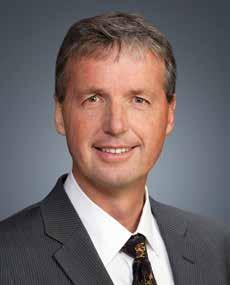
during the conversation and consider the discussion as a whole. I don’t think I have ever been out with other geologists in the field and come away with dissatisfied other than it ending to soon.
3) How much have you worked in western Canada vs. other geographic areas? And how has this influenced you as a Scientist?
a. I have been fortunate to get my early training in western Canada but did have minor assignments in eastern Canada, Australia, and New Guinea. By the time I left Amoco I had completed a study
(Continued on page 10...)



RESERVOIR ISSUE 3 • MAY/JUNE 2017 9 well-site geology·geosteering· petrography·on-site XRD· sample lab analysis· core supervision· reservoir characterization opsgeo@petroexplorers.com www.petroexplorers.com 403-260-5395 J. Douglas Uffen, P.Geoph (APEGA), P.Geo (APEGBC) Over 30 years of experience in Seismic Interpretation Coordinate Geoscience Project Management / Business Development Initiatives Domestic (Plains & Foothills) / International Conventional / Unconventional Exploratory / Exploitation / Development Modes With Software Licenses to: Seisware Kingdom Suite GeoSyn WINPICS
TALKING WITH ARCHITECTS
WITH ARCHITECTS
(Continued from page 9...)
Leave of Absence to get my Ph.D. from U of C, and was working in the Foothills of western Canada. I switched to Morrison, at that point I worked about one third international and the rest in the Canadian Foothills. The pace at that time was fast as Morrison wanted to drill, and dominated as much as possible. Although busy it was great fun as the leadership of the company wanted activity and was generally disposed to drill. This had a great influence on me as I was inundated with data and the only constraint placed on me was how much work and data we could get through.
After Morrison I went to NorthStar and though they were not as aggressive they were still pro drilling. This caused me to refine my thinking better and soon I found that I could probably open my own consulting service. Once NorthStar sold to Devon Energy I launched my own consulting services and Devon was supportive and hired me to continue providing technical services to them. I also picked up several clients and soon found that my practice was mostly international with clients in Africa, the Middle East, the North Sea, western US, the East Coast of Canada, and a bit in South America. This broad experience helped me to develop as a scientist. One particular trip for Western Zargros to Kurdistan gave me the opportunity to observe mountain building in the Zargros Mountains. This really helped me to think in how various pressure systems develop as a result of these mountain building processes.
4) What were the biggest changes/ challenges you personally noticed transitioning from a conventional oil and gas focus to an unconventional one? Perhaps a few comments on the state of basin, the evolution which it has gone through, and the future that it might hold. Working for a company that has operations throughout the world, wondering if you could share some of your perspectives.
a. The challenge going from conventional to resource was not apparent to me at first. I thought it would be a bit faster but maybe no more or less technical than what I was used to. It was probably around the mid 90’s when I was working foothills that I started to notice that when it came to reserves we could never put enough gas
into our understanding of the reservoir to reflect the ultimate production. We had to be dealing with larger drainage radius than we could calculate. Also, I did not truly appreciate the role of Big Data or how the thinking had to adjust to these large data volumes. I was ready for the drilling machine and I was ready for the disagreements that would surely pop up as people get stressed by the pace. I was not ready for the fact that the answers were not always apparent. It is hard to look for answers when questions can’t be agreed upon. I thought the fundamental question would be how do we get more oil out of the ground but many of the colleagues were only dimly aware that hydrocarbons came out of the ground. Their interest was how to we keep the machine running smoothly. I saw this with a few clients and realized that my temperament was not suited to this type of work.
It was at this point that we formed Shale Petroleum and started developing plays and buying land that would eventually be bought from us by bigger groups that wanted to open a new front. We were having good success then the oil price collapsed and the only thing that dropped faster than the price of oil was the price of land needed to find that oil. At that time we held 100% working interest in 400 sections of land (a quarter million acres). The good news is that we did not hold debt and we all continued to get along. The bad news was the land became a rental liability and was worthless. I think we will find that eventually geology will become more important than ever but I think we will also find that the industry will become more volatile and that to be a technical expert in a volatile work place will have a new set of pressures.
Questions focused on career development:
1) What attracted you to the Earth Science discipline, and when did you realize you wanted to focus on the field of Geology? Why did structural geology become such a focus for you?
a. I was originally attracted to Biology and wanted to do research in fresh water lakes. We had a High School trip that visited a research centre on Lake Ontario and I found it fascinating. I went to Queen’s with the hope to be a biologist but the first year Biology professor was uninspiring and
could not understand anyone wanting to be in first year biology that did not want to go into Medical School. The labs were a series of memory work and I was bored. Fortunately I took first year Geology because my older brother said it might be interesting. The geology Prof (Al Gorman) was fun, motivating, and anxious to communicate his passion for geology, it stuck for me.
When I went back to grad school I wanted to combine geophysics with field mapping. A Senior Geophysicists (Andy Papp) found data for me in Turner Valley and I thought that it might work. This turned out to be the first detailed integrated study of the Triangle Zone. Quite simply I was lucky to be at the right place at the right time. Geometry was my favourite subject in High School and suddenly I was doing 3D analytical geometry, working outside, given seismic data to tie into, and trusted by my supervisors. It was magic.
The structural geology community in Calgary had declined significantly but as new graduate students came out of the universities into industry there was a surge in interest and an explosion of new ideas, techniques, and mostly discussion. Within a year the Structural Group went from a few students to a room full of interested young scientists. There were some crazy ideas but it was a time where everyone wanted to share and the senior members had the wisdom to let the younger workers discuss ideas. Oil companies began to encourage field work and the structural community had the good sense to know how to share without giving up secrets.
2) As industry moves from conventional to an unconventional exploration/ exploitation what are some key structural geology applications you have noticed of critical importance? What are some triumphs and pitfalls you have observed?
a. I think the industry is more aware of the fluid / rock interaction and the importance of trying to understand systems that are dynamic. We are now dealing with rates rather than volumes. Our engineering colleagues are aware of this but they still seem to want to translate a rate into a volume. Practically this means that the assumptions in reserve analysis become
10 RESERVOIR ISSUE 3 • MAY/JUNE 2017 TALKING
more opaque. This means that we have developed this concept of Fracture porosity without understanding how fractures work. I think one of the great advances in petroleum geology to come will be how we deal with petroleum generation and migration. We recognize that fluid migration has little to do with bouyancy and more to do with geopressure, hydrocarbon generation, geomechanics as well as other factors.
Structural geology will have to not only look at specific features but also discuss the basin as a whole. It should be tremendous fun.
3) What were the biggest changes and/or challenges you were faced with transitioning from a large international company to smaller E&Ps. How can students/professionals today best prepare for this?
a. I was lucky to start my career with a company that was dedicated to training. Due to the downturn the training budget for companies has become near non-existent. I am sure there are some companies that say they train their staff, but my experience is that half of the training is in the softer issues of corporate life and not the hard sciences of geology, geophysics and reservoir engineering. This creates an onus on the younger geologist to seek training and new experiences constantly. The best way to prepare for this is to honestly assess your development constantly.
Early in my career I received the advice that one should always be on a steep learning curve. If you found the curve to drop you should find a new job. That was easy advice when jobs were abundant but the point is still valid. When we get comfortable in the job we are likely cruising and heading towards redundancy. Our curiosity should be insatiable. Curiosity is one of the traits that I look for in potential employees. This trait tells me that they are motivated, anxious to learn, and they will ask questions.
The other important characteristic is a willingness to try something new. In a small company there are very few experts available so one has to expand contacts, network constantly. It is ultimately the individual’s responsibility to market themselves, giving talks and publishing in the Reservoir are great venues for this.
4) Starting your own consulting practice can be challenging. If any of our readers have similar aspirations, do you have any advice? What qualities / abilities would you suggest honing / mastering? Or if you’d like to share some pearls of wisdom on how you have achieved success in the oil and gas industry (i.e. what skill-sets would you recommend having).
a. Get a good accountant first. In the consulting world one needs a marketable skill otherwise you are competing on price and there are more and more people willing to work for less. Consulting can be challenging as you are in constant marketing (sales) and also delivering a confidential product. The consultant is under pressure always to deliver. The important soft skill is to be a good communicator, which means the ability to listen to the client and understand both the problem but also the scope.
When I first stated I was comfortable in the geology of thrust belts and had some ability in extensional systems. I was given projects that usually involved a sizable amount of strike slip. It then hit me that people give consultants two types of projects, one with a very short time frame that they can’t manage or difficult problems that they don’t want. I found that I seemed to do better when I was the company’s consultant and not an individual’s consultant. In other words I made sure that I spent the time talking to the entire team and tried to address the problem for both the engineers as well as the geoscientists. I would also take time to talk to the manager. This way everyone understood what I was doing and similarly I saw the broader problem. Most of the sessions were 15 minutes in an office over a cup of coffee. I found this to be an effective way to stay out of office politics.
5) What were the biggest changes and/ or challenges you were faced with transitioning from the technical side to a management/business side? How can students/professionals today best prepare for this? Or would your advice be to “stay technical?”
a. I had a boss at Amoco (Ken West) who told me that I should never lose my technical ability. This proved good advice to me but I do find that in business
I am constantly trying to make sure that I understand the issues around the business side of the industry. The reality is that one cannot be good at everything. The other reality is that you never really should make an important decision quickly. If someone says they need the answer to an investment decision immediately it is probably time to walk away. We run our company as a collaboration. This does not mean that we always agree but we do know that if we sit down and talk things through we rarely go too wrong. I am not the business expert or the technical expert. My job is to make sure one does not get too far ahead of the other.
6) What are some key messages you would like to share with the industry professional just starting their careers? (Starting to collect, analyze and apply geologic/structural data)?
a. Learn to become impartial but at the same time develop a hypothesis that you are constantly developing. Essentially the scientific method. Geologists that fall in love with their interpretation are usually wrong. Geologists that refuse to make an interpretation are always wrong. Geologists that adapt and remain open minded are usually successful. It really is what is the principal motivator, personal advancement or insights into a fascinating science; rarely will both of these come at the same time. My most beneficial projects were always collaborative. I found as we progressed as a group I was able to gather insight but also had fun and growth. It is the classic comment; a forest grows best when all the trees grow together.
7) Can you describe some of your favourite projects over your industry career?
a. I was able to work on was a Special Issue of the Bulletin of Canadian Geology where we described the foreland edge of the thrust belt. It was a collaborative effort amongst six of us and I find I have maintained a friendship with my co-organizers. This was the first detailed account of this structural feature and seems to generate a conversation within the Structural Community that still resonates. Again I was lucky to be involved in the right project at the right time. This also coincided with a resurgence in the Structural Division of the CSPG. I find that this is where I like to float
(Continued on page 12...)
RESERVOIR ISSUE 3 • MAY/JUNE 2017 11
TALKING WITH ARCHITECTS
(Continued from page 11...)
new ideas or take old concepts and put a twist on them. We have an amazing brain trust in geology and in particular structural geology in the CSPG. Much of it has to do with our close proximity to the Rocky Mountains and the relatively easy access. I suspect that there is another project simmering within that group and it will be fun to see it develop.
8) How has being the President of the CSPG changed your perspective of the oil and gas industry, especially as a Geologist? I assume that your focus must shift away from the rocks a little, but are there certain aspects of this industry that keep you focused technically?
a. The role as President of the CSPG was very rewarding. I think the best part was the ability to be welcomed into so many different groups and to see the amazing cross-section of people who make up the CSPG. As in any group there are personalities and not everyone has the same motivation but I do not remember any member who said they were a geologist for the glory and fame. What I found was that I got to be the cheerleader for a very large and enthusiastic group.
The deeper message was that geologists have a deep passion for their science. I have never come across a geologist that hates geology. I suspect that is rare in any profession but in geology I get the impression that most people are geologists first and employees second. I noticed that when asked what they do many people say who they work for but geologists seem to say they are a geologist and then may mention a company. It is a little things but it goes to motivation. The role didn’t change my perspective but it did emphasize to me what an incredible opportunity I was given to work with such an enthusiastic group. It was a very special time in my career
9) You have been such a large part of the CSPG and have held many roles and responsibilities. Which roles were the most impactful for your career/ personal development? Which roles were the most “fun”?
a. I held some roles that I was dismal at, but fortunately they do not hand out failure
awards. I have already discussed the role as president but I also enjoy helping with the convention, especially in 2011 when we decided that we would do integrated session focussed on resource plays. We moved the conference back to the Telus Conventions centre (from the Stampede Grounds). There was a transition so we did not have as much direction as other years but we also did not have pre-conceived idea so we did what seemed to make sense. The executive of the different societies were very supportive and gave us a green light on most of the things we wanted to do so it was one of those perfect moments when you have energy, help, and people removing barriers. I still have people come up to me saying how much they enjoyed it.
What I remember most about it was how helpful everyone wanted to be. This was one of those times when I saw the best of people. It was magic.
10) This edition is dedicated to the 2017 GeoConvention and Core Conference. Can you comment on the importance of these type of knowledge sharing events? Benefits? Amount of work for that goes into organizing them?
a. The conference is in my opinion the most important part of the society. This is not said to diminish the importance of the division talks, courses, field trips, publications, lunches or the many other things the Society does. I feel this because the convention brings together up to 4000 geoscientists who spend great effort to discuss their science. Many important discussions get their start at GeoConvention. It is a meeting place for ideas and it is fascinating to listen to the conversations that occur throughout the Convention Hall.
At one point I had a bit of time and thought I would walk through the exhibit hall slowly and listen to the conversation. There were people talking about basics principals and also very specific techniques. People were discussing all aspects of geology some cautiously and others with great vigor. I sat down and simply watched our members. There was engagement, enthusiasm, happy faces, earnest faces, doubtful faces, concerned faces. There were smiles, handshakes and the odd hug and pat on the back.
I do understand the amount of work that goes into it but the benefit is so much more. Occasionally I have had a few people tell me that they didn’t enjoy a particular convention. My advice is that the more you put into the Convention the more you get out of it. If you want to advance your career present at the conference, volunteer, judge, or simply attend. I have never been disappointed with the convention and have always found any effort I put into it to be well rewarded.
11) Specifically, what was your involvement in the formation of the GeoConvention Partnership? What was your overall intent and how was the idea of a formal agreement devised?
a. I had the good fortune to be the signatory on the GeoConvention documents. When Rob McGrory and I finished our co-chair responsibilities for the conference in 2011 we both thought that it was obvious that the conference should always be joint. The JAC agreement was set to expire and rather than extend it there was a desire to create a more permanent solution. We both felt, as did many others that Calgary could consistently pull off a meaningful geoscience conference it only needed a gentle push. The purpose of the convention is to be the premier petroleum geology meeting in North America focused on North America. We are not in competition with the AAPG ACE as that is international in scope and we are not trying to dislocate the other more regional conferences as there are important roles for those meetings. GeoConvention is a unique opportunity to attend a fully integrated conference mixing geology, geophysics and petrophysics. It is said that advancing any one field is exceptionally difficult. GeoConvention does not try to advance any one specific field but instead advance the overlap between fields. It can do this because of the unique opportunity. The conference is held in Calgary amongst a mobile flexible workforce that is generally supported by their companies and the broader industry. The volunteer spirit of the population and the broad experience it represents gives the conference a strong foundation. If one were to read the agreement they would see that GeoConvetion is a partnership. It is not a separate organization but rather the
12 RESERVOIR ISSUE 3 • MAY/JUNE 2017 TALKING
WITH ARCHITECTS
coming together of three strong technical societies and thousands of scientists. It is intended to be something that the three different societies will work together to create. The only way it can fail is if the three sponsoring societies decide to not get along. The best analogy of the strength of the partnership is a rope. A single strand rope is only as strong as that single strand but a three stranded rope that is wound together is stronger than the sum of its parts. This is GeoConvention. There will be obvious bumps in the road but the three societies have dealt with many problems and have consistently come out stronger with greater service to its membership.
Questions centered on more general / personal items:
1) Tell us something about the personal side of Paul Mackay. What are your interests outside of work?
a. Between family, work, and volunteering there really isn’t much time. I would like to take time off and write but that does not seem to be in the picture right now. I know my most enjoyable time seems to be spent with friends and family. I used to woodwork but that is more difficult to accomplish these days. I always thought that music would be fun but my closest friends have suggested that it is not much fun for those around me. One thing I would like to do is make a log cabin. This worries my wife.
We have started up a geologist hiking group where we try to go out and look at rock on a very informal basis. We have had two trips and we emphasize that there is no one in charge, no organization, no fees, no itinerary. The one thing it seems to deliver are very special days with friends, young and old, looking at rock and if possible a bakery along the way.
2) What are your plans/goals for the next 3 to 5 years outside of work?
a. I built a greenhouse on our land and I would like to get that fully operational. I put a Peach tree in it and have actually been getting reasonable peaches. Although there are more lucrative crops to grow in the greenhouse, we have stuck with tomatoes, and cucumbers. This is starting to become a runaway hobby with the inclusion of two bee hives, an outdoor garden, and a fish pond.
I would like to hike the Alps in the next few years. Two close friends took me out in 2015 and it was a wonderful experience so that is something I would like to do on a broader level.
I am also involved with the University of Calgary and Queen’s University. At the U of C we are trying to build closer ties with the Industry, in this way engage the broader geology community in the advancement of geology. At Queen’s I am teaching a course on the Energy cycle, which has been eye
opening for me.
3) Are your holidays spent visiting outcrops or famous geological sites?
a. We were on a family trip when our three children were in their late teens. We were waiting at a gas station and what started out as a two minute stop quickly progressed into a major event that was going to take much longer than 30 minutes. My daughter and I were both waiting so I stood up and walked over to an outcrop that happened to be on the side of the road by the gas station. It had a very interesting growth fault in the middle of it and I was admiring it when my daughter came over and asked what I was looking at. I pointed it out to her and she took my arm and looked at me and asked very genuinely, “Do you ever get bored?” I have never thought of it before that but I don’t think I have ever been bored looking at rock. There is always something to see. ITwo of our children went into Geology the third one went into Applied Math (the smart one). Is Geology a good career? I don’t really know how it will change but when I started 37 years ago I was told that geology was fading as the big resources have all been found. That advice was wrong. I suspect that if you enjoy the science of Geology then you will be useful to society and it will be a good career. We are a long distance from understanding the intricacies of the Earth and how it was formed.

RESERVOIR ISSUE 3 • MAY/JUNE 2017 13 TALKING WITH ARCHITECTS
A HISTORY OF GEOCONVENTION
By Ron Larson, Gord Lee, Robert McGrory, Tony Cadrin, Rob Kendall, Paul MacKay
Formally, GeoConvention began in 2013 with the signing of an agreement that committed the CWLS, the CSEG, and the CSPG to a limited partnership that was designed to provide a showcase technical conference dedicated to the petroleum geoscience of Canada and parts of the United States. The agreement took a dedicated committee of 7 volunteers from the three societies (3 from CSPG, 3 from CSEG and 1 from CWLS) and input from the executives of all three societies almost a year and half to negotiate.
Although the agreement was signed in 2013 the three technical societies had been collaborating for over a decade on joint conventions.
The early roots of the GeoConvention began in the early stages of the Alberta Geological Society (AGS), who would have meetings in Banff to look at rock, socialize, and have a few days out of the office. These could be raucous affairs and were generally well attended by the relatively small membership. In the 1970’s and 80’s the CSPG Convention grew exponentially, however it was not the only party in town as the CSEG was also established and growing quickly. At this time there were clear distinctions between Geologists and Geophysicists. In many oil companies, they kept these two disciplines apart and in some cases they would not cross-train one between the disciplines for fear that individual employees would become too valuable and would leave. Once the NEP (National Energy Program) hit in 1980, the party died. What followed was a protracted slump in oil prices and deterioration in the employment of new graduates into the industry. Through this time, the companies learned to do more with fewer people. This was greatly facilitated with the advent and use of micro-computers in the office. The labs, research centres, large log libraries and main frame computers that each oil company maintained to process seismic data became a thing of the past. Companies began to outsource everything

that was peripheral to the main task of finding and producing hydrocarbons. Service companies began to emerge as both significant employers and drivers of new technology through their investment in research and development. Also the service industry became an increasingly important employer in the industry. The service companies needed to show case their abilities and the individual conventions of the three societies became an important marketing tool for that purpose.
Eventually three conventions became simply too much and the societies began running joint conventions some years and separate events in other years. The membership of the societies clearly showed a preference for joint conventions although there were still some that preferred isolated conventions. Gradually this opinion became a small minority and the membership insisted that in the future the conventions should be joint. A Joint Annual Committee on Conventions (JACC) was formed, September 2007, and a formal process was begun to hold an integrated convention.
JACC started out with a committed group of volunteers from each of the three societies that were selected by the executives from each of the member societies. These volunteers were tasked with identifying: General Co-Chairs, technical chairs and the rest of the core set of volunteers to run the joint conventions. The CSPG and CSEG would each act as an operator on a two year rotating basis. This was critical for the Convention Committee’s ability to conduct its business. The infrastructure made available by the societies to the Convention Committee such as meeting rooms, accounting, banking and a convention manager were critical to the success of each conventions. Like most things the idea was good but one of the great problems for the operating societies was the volunteer nature of participation and the revolving door of leadership (convention managers). Some years relationships were good and other years, relationships were sticky. Like any relationship there are highs and lows. Additionally, the JACC model was very restrictive in the ability to forward plan and develop our convention as a brand.
14 RESERVOIR ISSUE 3 • MAY/JUNE 2017 GEOCONVENTION ARTICLES
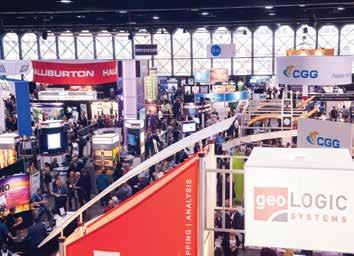
The one thing that all three societies could agree on was that the convention was one of the most important events of the year from a technical and social point of view, as well as providing significant funds to support each society. From this, GeoConvention was born. Once again, a committee of seven volunteers was struck, made up of former members of JACC, former General Co-Chairs and significant joint convention volunteers and executive members of all three societies, tasked with evaluating JACC and charting a longer term course for our beloved convention. There was some reluctance from a minority of the membership of all three societies to enter into an agreement that had permanence to it, but overwhelming the majority of the membership was in favour of the formation of GeoConvention and the opportunity that it brought to each society and their membership. After a year and half of planning, negotiating and with both legal and financial advice, GeoConvention
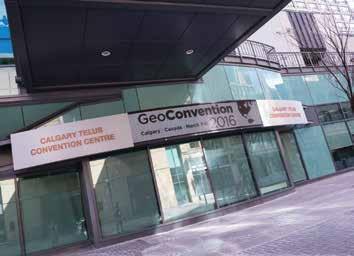
Partnership LLP was born.
With GeoConvention’s launch in 2015 and subsequent meeting in 2016, it ran into a perfect storm of a severe downturn and the annual 10 year arrival of the AAPG Annual Convention and Exposition. The amount of competition created by this event at a time of great contraction of the oil industry, created a situation that would put most new ventures out of business; however, with careful planning and prudent management, GeoConvention weathered the storm and came out of the last year with great experience and clear commitment from the sponsoring societies that they are committed to the brand and unified approach.
There will likely be other struggles that GeoConvention will face but the advantage of last year is the realization that the community values GeoConvention, and that there is a true need to meet, share
ideas, see what is new, renew friendships, and have a party. GeoConvention is a strong brand that will recover in the coming years. It is a significant scientific meeting, an excellent opportunity to showcase technology, an efficient method to keep abreast of industry, and one of the best networking opportunities for geoscientists during the year. Future generations will find ways to make it better but as long as we meet as one group we will continue to advance both our science and industry.
Historically, our three societies have housed many of the greatest pioneers of the petroleum industry and have contributed greatly to the global understanding of the subsurface. Collectively, we can all stand proud as Canadian geoscientists and the foundations set by GeoConvention enable us to showcase the wisdom, talents and abilities in our profession for many years to come.
Tuesday, May 9th 11:45 am - 1:00 pm Fairmont Palliser Calgary, Alberta Room
RESERVOIR ISSUE 3 • MAY/JUNE 2017 15
GEOCONVENTION ARTICLES
DON’T MISS OUT ON THE 2017 CSPG AWARDS LUNCHEON & INDUSTRY SPEAKER LUNCHEON
Following the awards presentation Ted Bogle (2016 Stanley Slipper Winner) will give a presentation
THREE YEAR GEOCONVENTION STRATEGY
By Steven Donaldson & Kathleen Dorey
The first Calgary GeoConvention run and steered by the newly formed GeoConvention entity occurred in 2015. With two geoscience conventions now behind them the Board of Directors of the GeoConvention can now move from initiation mode to thinking about longer term strategies.
The Board of Directors was formed as a result of the creation of the GeoConvention Partnership. The current Board comprises representatives from the three Partner societies; the Canadian Society of Exploration Geophysicists (CSEG), the Canadian Society of Petroleum Geologists (CSPG), and the Canadian Well Logging Society (CWLS). There are three representatives each from the CSEG and CSPG, with each member chosen by their respective societies; the CWLS has selected one representative to serve on the Board. Representatives typically serve for a 3-year term. The current GeoConvention Board members are listed below, along with their affiliations:
Name Society Representation
Nancy Laing CSEG
Jeff Deere CSEG
Kathleen Dorey CSPG
Steve Donaldson CSPG
Phil Esslinger CSPG
Heather Makowecki CSPG
David Brooke CWLS
A Partner society strategy session (CSEG, CSPG and CWLS) was organized by the Board of Directors in November 2016 to review and sharpen the GeoConvention three-year focus in terms of meeting shorter term financial goals, optimizing partner society relations and communication, improving operational methods, and improving the organization of the GeoConvention Board. As a result of this meeting, five key action items were
identified to enable the GeoConvention Partnership and Board to meet these shorter term goals. These are outlined below:
Emphasize to Industry Executives the Value of Training and PDH’s offered by GeoConvention:
• Reach out to APEGA to publish an article in the PEG Magazine explaining how the GeoConvention can help members earn their professional development hours (PDH’s)
• Communicate GeoConvention training advantages via a letter that will be distributed to high profile geoscientists at individual companies
Diversify GeoConvention Content by Inviting other Organizations to Participate:
• The Canadian Society for Unconventional Resources will now be hosting a session at GeoConvention 2017
• Likewise, the Calgary Mineral Exploration Society will also be hosting a session this year
• GeoConvention 2017 will include sessions on financial markets, long term oil and gas strategies, infrastructure, regulations, safety, and environmental protection
• It is anticipated that this initiative will increase the number of delegates attending GeoConvention and help maximize revenue
Increase Media Attendance at the GeoConvention:
• A Media Chair is now assigned to handle the issue for GeoConvention 2017
• Will invite media to specific high profile sessions
• This will have a positive impact on sponsors/exhibitors and potentially increase future attendance at GeoConvention
Initiate a Joint Brain Storming Session in June 2017:
• Planned to immediately follow GeoConvention this year, earlier than in
past years
• General Convention Chairs, Technical Chairs (old and new), GeoConvention Board and Partner Society Presidents will be invited
• Best of Sessions of other Societies conferences – Virtual or pre-recorded sessions
Generate a Memorandum of Understanding with Partner Societies:
• In an effort to optimize partner society relations, the GeoConvention Board will draft a Memorandum of Understanding (MOU) with partners to make relationships clear and equitable with the partner societies.
Maintaining fiscal responsibility while growing the GeoConvention brand through diversification of programming in the short term will be achieved through strategic cost control, vendor relations, as well as prioritizing the organization's efforts on the five initiatives listed above. Once the sustainability of GeoConvention at low commodity pricing has been established, the opportunity for geographic diversification can be discussed and explored.
In this rapidly changing oil and gas business and economy it is crucial for our industry and professional societies to stay current on technical advancements and business developments. As such, the GeoConvention Board and Executive see an exciting role for this landmark yearly conference and look forward to diversifying the content and expanding the experience for all future stakeholders in the coming years.
TECHNICAL ARTICLE 16 RESERVOIR ISSUE 3 • MAY/JUNE 2017 FUTURE GEOCONVENTIONS
GEOCONVENTION BOARD
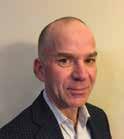
David Brooke
David Brooke has extensive experience within the North American petroleum industry with over 20 years as a Petrophysicist, Operations Manager, Field Engineer and Environmental Consultant. David graduated from the University of Alberta with a Bachelor of Science in Chemical Engineering in 1991. Job responsibilities have included working as a Field Engineer in Alberta and Newfoundland, along with several line management positions in Texas and Oklahoma before returning to Alberta in a Business Development role in 2010, and Petrophysics and Well Integrity work starting in January 2012. David has worked on the Technical Committee for the SPE Thermal Well Integrity Conference in 2013. David is a member of APEGGA and SPE, along with the CWLS. David also volunteers as Vice-President for the Deer Run Community Association.
Jeff Deere
Jeff has been a CSEG representative on the GeoConvention Board since June of 2016. He was the CSEG general co-chair for GeoConvention 2015 and was a member of the technical committee for several past conventions. From 2007 to 2010 he was a member of the editorial board for the SEG publication The Leading Edge where he coordinated the monthly Acquisition and Processing section. Jeff has been the Chief Geophysicist at Key Seismic since 2006. Prior to joining Key Seismic, he was at Veritas DGC in Calgary and Shell in Calgary and Rijswijk, Netherlands.

Steve Donaldson
Steve Donaldson is one of the three CSPG representatives currently serving on the GeoConvention Board, and has been in that role since August 2015. Steve served as a session co-chair at last year's GeoConvention, as well as a session chair
at an earlier CSPG Convention. He has also been the co-chair of the CSPG Basin Analysis and Sequence Stratigraphy (BASS) Division for over 13 years.
Steve is currently working with Partners Energy Development Corporation in Calgary, and is a Professional Geologist with 15+ years of experience in the oil and gas industry. Starting out as a Consultant, he transitioned into full-time roles of increasing responsibility with some of the larger oil and gas companies in Calgary.
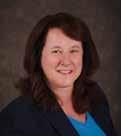
Kathleen Dorey
Kathleen Dorey is a Professional Geophysicist and a present/past member of the CSEG, SEG, CSUR, CSPG and APEGA.
Kathleen has over 25 yrs experience as a Geophysicist in major operating companies such as Texaco and Conoco, and as an independent geophysical consultant for many junior oil and gas companies. She has been Chief Geophysicist for the Petrel Robertson Consulting Ltd for the last 7 years focusing on Canadian and International geoscience projects. Kathleen has contributed to and presented talks for the CSEG, EAGE, CSPG and AAPG ICE. She currently serves on the Geoconvention Board of Directors, is a past member of the CSEG Executive, served as Session Chair for the Geoconvention since 2013 and is a past SEG Convention Program editor.

Nancy Laing
Nancy Laing currently serves on the GeoConvention Board of Directors as the Board Chair and as one of three CSEG board representatives. Nancy has been active with GeoConvention since 2013 when she served as Mobile App Chair for both the 2013 and 2014 Conventions. Nancy also volunteers with the CSEG on the New Initiatives Committee.
Nancy is currently Marketing Director at Canadian Discovery Ltd, an oil & gas products and services company in Calgary. As Marketing Director, Nancy oversees the marketing and strategic planning for the company. She worked as an industry geophysicist for 10 years before pursuing film and television production. For 17 years, Nancy produced award winning feature films, television movies, documentaries and factual series for Canadian and international markets. She returned to geosciences in 2010 as CEO of Sound QI, a quantitative seismic interpretation consulting company, before it was acquired by Canadian Discovery Ltd. in 2012.
Nancy is looking forward to spending time on the Exhibit floor to connect with clients, network with colleagues and catch up on the latest technology and trends at the booths. She’s also excited about the half-day panel discussion on The Future – How our Profession is Advancing and Changing as well as On the Offensive – Strategic Staffing for a Thriving Post-Recovery. And she’s keen to see the luncheon talks with Mark LaCour and Jacob Corley talking about ‘Pulling ahead in the midst of change’ and Jurgen Kraus’ ‘Geology of Beer’ as well as Tom Feuchtwanger’s Chasing Adventure; Circumnavigating Africa Overland.
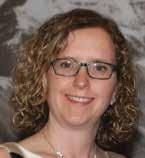
Heather Makowecki
Heather Makowecki is a professional geologist with 14 years of experience in Western Canada. She has been involved with the GeoConvention since 2015 in a variety of roles. Heather believes in the importance of sharing knowledge and ideas throughout our industry and feels very strongly that the GeoConvention is a unique event that brings Geoscientists together.
RESERVOIR ISSUE 3 • MAY/JUNE 2017 17
GEOCONVENTION ARTICLES
COMMITTEE BIOS

Gary Bugden General Chair of the 2017 Geo Convention representing the Canadian well logging Society (CWLS)
Gary graduated from Memorial University of Newfoundland in 1997 with a B.Sc. in Earthscience. His 20th year career in geology has encompassed hard rock exploration, wellsite geology, play geology as well as several stints in oilfield sales and R&D. Gary is currently a partner at Cabra Consulting Ltd. where he holds the position of Vice President Geological Operations.
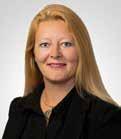
Nanna Eliuk
Nanna Eliuk is General Chair for the CSEG at the 2017 GeoConvention in Calgary. Nanna has been an active and tireless volunteer on many fronts with the CSEG. She has served as session chair and co-chair for both the CSEG/CSPG Conventions in the past, has been an integral part of the technical committee for past conventions, written book reviews for the RECORDER, reviewed abstracts for the SEG Convention, as well as helped organize and present at the first CSEG/EAGE Land Seismic workshop, which was a financial and technical success. She has also volunteered her time with the Earth Science for Society, the CSEG Mentorship program, the CSEG Outreach program (high school fairs in Saskatchewan) and was a key contributor in the early days of the Junior Geophysicists Forum Committee.
Nanna is currently Exploration Manager with Alvopetro Energy Ltd. in Calgary and is a professional geophysicist with over 20 years’ experience in the oil and gas industry. Her experience has included geophysical positions with increasing
responsibility at junior as well as integrated multi-national oil and gas companies in Calgary.
Special interest sessions that she is looking forward to include some of the panel discussions such as Global Carbon Capture, Storage, Utilization and Monitoring, Pipelines and Transportation, The Modern Geoscientist Panel, The Future of the Oil and Gas Industry in Canada: Needs for New Business Strategies and Technological Innovation, The Value of Geophysics Panel, Wellbore leakage and gas sources, Workplace Culture/ Diversity as well as some of the 100 poster presentations. You will find her networking on the exhibit floor and at each of the three luncheons.
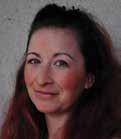
Lynn Engel; BSc.; P.Geoph.
Lynn Engel has been the GeoConvention Chairman for Judging and Awards for the past 3 years. She also assists with the CSEG Lunch Box geophysics talks.
Lynn has 20 years’ experience as a seismic interpreter, and has focused the last 5 years on QI (Quantitative Interpretation). She won the Best Integrated Oral presentation at the 2013 GeoConvention for the paper “Case Studies Highlighting Tight Sand Reservoir Interpretation of AVOInversion Techniques”. She is currently working at Bengal Energy, performing QI and traditional seismic interpretation workflows in the Cooper Basin, onshore Australia.
Lynn is also an active volunteer around Calgary. She volunteers for the Calgary Wildlife Rehabilitation Society, where she fed over one hundred orphaned baby hares. She was a member of the Tatawaw Committee which sponsored a Syrian refugee family. You might run into her at the Calgary Zoo, observing the black bears,
or assisting with the penguins on the King Penguin walk, or inside the Penguin Plunge.
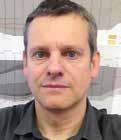
Tristan Euzen
Tristan Euzen is a geologist with over 20 years of experience as a researcher and a consultant, most of it in relation with the petroleum industry. After a PhD on plutonic rocks, he started working in the mining industry and switched early in his career to the oil and gas industry. In 1996, he joined IFP Energies nouvelles, a research, training and information center for sustainable development in the fields of energy. During 10 years as a Geoscientist at IFP, his research interest has been on reservoir characterization from outcrop and subsurface data, and closely related domains such as sequence stratigraphy, sedimentology, static reservoir modelling and stratigraphic modeling. Tristan Joined IFP-Canada in Calgary 10 years ago, because he wanted to get closer to the industry and get a better understanding of how research may impact strategic and operational decisions. For the last six years, his focus has been on unconventional resources with a special interest in the Montney play. With a relatively broad geoscience background and most of his career spent at the frontier between the academia and the industry, Tristan naturally leans towards multidisciplinary integrated projects to improve knowledge on and help responsibly develop oil and gas resources.
Last year, Tristan Euzen was involved in the GeoConvention 2016 as a Montney Session Co-Chair and it made him realize how important it is to design a consistent agenda and actively recruit speakers to build a strong technical session. This session was such a success and his CoChair Tom Moslow had the brilliant idea to make it the starting point of a new Special Volume on the Montney Play for the Bulletin of Canadian Petroleum Geology! For the GeoConvention 2017, Tristan was
18 RESERVOIR ISSUE 3 • MAY/JUNE 2017
GEOCONVENTION ARTICLES
offered a role of General Co-Chair for the CSPG, as the position had become vacant. This position is a great learning opportunity because this kind of role forces individuals to take a step back and look at the bigger picture and a longer-term perspective. It also makes it possible to bring new ideas into reality thanks to the enthusiastic and strong involvement of the GeoConvention committee! Among the committee’s objectives this year, were building a strong and more diversified technical program, attract high profile Session-Chairs and speakers, as well as a broader audience with more executives and people from the midstream industry. The technical program that was finally put together this year went even beyond the committee’s expectations with nearly 60 sessions and panels and the GeoConvention 2017 is set to be an excellent vintage!
Tristan Euzen will also be co-chairing two technical sessions at the GeoConvention 2017. The first one co-chaired with Neil Watson and entitled “Western Canada Petroleum Systems” will cover a variety of aspects including tectonics, sediment source-to-sink, oil sourcing and fluids migration. The other one will be the last of three sessions on the Montney Play, that will be one of the hot topics of the conference again this year! This session co-chaired with Brian Zaitlin will be entirely devoted to “New Insights on Stratigraphy and Sedimentology”. The stratigraphic architecture and the depositional heterogeneity of the Montney Formation have a fundamental impact on the distribution of both rock and fluid properties throughout the basin and there will certainly be a lot of useful take away messages out of this session!
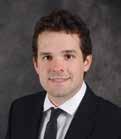
Adam Fraser (P.Geo) CSPG Technical Co-chair
A professional Geologist and independent consultant with 5 years of experience in the petroleum industry having worked for EnCana Corporation, Talisman Energy Inc., Imperial Oil, and ConocoPhillips Canada. Experience
includes the Ellerslie, Glauconitic, Notikewin, McMurray, Dunvegan, Bluesky and Cardium formations.
Adam graduated from Dalhousie University in 2010 with a BSc in Earth Science (Hons.) and University of Calgary in 2012 with an MSc in Geology. His undergraduate thesis is entitled ‘Trends and Architecture of Meguma Group Turbidites in Point Pleasant Park, Halifax, Nova Scotia’ and focused on turbidite sand body geometries and the location of the sands in relation to the seafloor. His Master’s thesis is entitled ‘Offshore and transitional Cardium reservoir evaluation for tight oil, West Pembina boundary, Alberta, Canada’ and focused on the deposition and reservoir characterization of lower shoreface sandstones in the Cardium Formation in relation to a higher order sequence stratigraphic model.
Adam enjoyed volunteering, presenting and co-chairing at past GeoConventions and joined the GeoConvention committee in 2016. At the 2017 GeoConvention Adam will be co-chairing the ‘Integrating Geoscience to Optimize Unconventional and Oilsand Resource Plays’ session.
Adam is looking forward to this year’s GeoConvension and excited about the diverse topics that will be presented covering not only fascinating geoscience topics but those related to government and public policy as well as career development.
Adam is looking forward to seeing you this year’s GeoConvention as it is expected to be one of the biggest and most diverse.
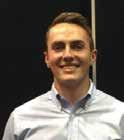
Nash Hayward
Nash Hayward is the Exhibits Chair for the 2017 GeoConvention in Calgary. Nash has been a persistent volunteer in past years, serving as part of the Speaker recruitment team for the student-run APEGA GeoSkills 2016 conference, as well as volunteering with Trican Geological Solutions in their analytical laboratory for nearly two years, assisting with daily
GEOCONVENTION ARTICLES
operations. Volunteering with multiple different organizations has proven to be extremely rewarding to Nash, through networking and project management with GeoSkills and GeoConvention, and the opportunity to learn about microscale reservoir analysis and technological innovations with Trican.
Nash had his first industry work experience this past summer with Tangle Creek Energy Ltd. allowing him to get a taste of the business and expand his network, gaining valuable mentorship and a love for petroleum geosciences.
Currently, Nash is in his final semester of his BSc. (Hons.) Geology (Petroleum Concentration) with Geophysics Minor program and is looking forward to the prospect of pursuing an International Master’s Program in Petroleum Geology beginning in September.
In addition to networking, Nash is most looking forward to the opportunity to attend technical sessions regarding The Future of the Oil and Gas Industry in Canada, Canadian Frontier Basins, Optimizing Resource Recovery, Global Carbon Capture, Storage, Utilization and Monitoring, Emerging Technologies, and Integrating Geoscience to Optimize Unconventional and Oils and Resource Plays at this year’s GeoConvention.
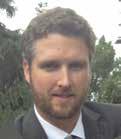
Jason Hendrick
Jason Hendrick is a geophysicist working for Nexen Energy, he is focused on unconventional resource development.
He’s been with Nexen for 10 years, his work experience includes seismic interpretation, innovative geophysical technology application, designing and implementing seismic and microseismic monitoring networks, actively contributing to various research consortiums, and technology development efforts dedicated to the advancement of geophysics. He’s been involved with the Geoconvention in all capacities over the past decade. Since he was a summer student in 2005, Geoconvention has provided
(Continued on page 20...)
RESERVOIR ISSUE 3 • MAY/JUNE 2017 19
GEOCONVENTION ARTICLES
(Continued from page 19...)
opportunities to network and explore the different facets of the Canadian Oil and Gas industry. The diverse technical content of Geoconvention allows new ideas to flow from presentations of new technologies, tools and case studies. Jason has presented multiple posters and an oral presentation at the Geoconvention over the years, contributing to the advancement of seismic attributes, microseismic monitoring and the research of induced seismicity generated from hydraulic fracturing. He has acted as a Geoconvention session chair for the induced seismicity sessions in 2016, helping to shape the content that was presented. Most recently, he has led the geophysical technical content coordination as the CSEG technical chair for Geoconvention 2017. Working as part of the Geoconvention organizing team has allowed Jason to recognize the hard work and hundreds of hours of work needed to produce the Geoconvention each year. He’s proud to contribute to his society, the CSEG, and to help ensure the best technical program is brought together. Jason is looking forward to the expansive technical content, with nearly 400 abstract submissions! Geoconvention 2017 highlights the resiliency shown during the industry downturn, as geophysicists, geologists and petrophysicists continue to share their ideas and innovate to help shape our future.
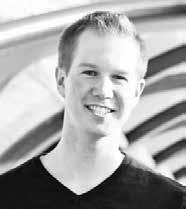
Brendon
Lybbert
Brendon has always found joy in exploring the great outdoors. Growing up east of the Rockies in Spruce Grove,
AB, his family enjoyed camping and all outdoor sports year round. When the time came to pursue an education, he began searching for a career that combined his passions of the outdoors with science, and found geology. Since attending school at the University of Calgary, his appreciation for all outdoor pursuits such as hiking, canoeing, skiing, and rock climbing have taken on a whole new satisfaction. Currently completing his Honours in Petroleum Geology degree this year, Brendon has been privileged to complete an undergraduate thesis project under Dr. Federico Krause with a sedimentary and petrology focus. Using core logging, sample collection, optical and scanning electron microscopy for detailed petrology analysis has allowed Brendon to consolidate his geological knowledge.
Volunteering and seeking ways to involve himself within communities has always been important to Brendon; a habit that began as a young boy participating in the scouting program and achieving their highest awards over the years. Fast forward to today where Brendon is happy to be a part of the 2017 Geoconvention committee working as a team on varying tasks to bring an event that will bring the geoscience community together to learn about innovations and research done by fellow peers. He looks forward to engaging in the technical talks and getting to know more about the methods/ technologies that are being incorporated in the today's industry. “A great deal of effort has been combined over the past year to bring a world class conference, and I am excited to see it in motion! I hope to see you there and wish you all the best!”
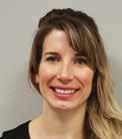
Brianna Saxton
Brianna Saxton is the CWLS Technical CoChair for this year’s GeoConvention. She is a junior petrophysicist for Apache Canada. She graduated from the University of Alberta in May, 2014 with an Honors Degree in Geology. After finishing her degree, she was hired on as a GIT at Apache. She has worked with Apache’s exploration group for 1 year, performing regional mapping in the WCSB. For the last 1.5 years, she has been working with Apache’s petrophysical group providing technical analyses to the Canadian asset teams.
Brianna likes being part of the GeoConvention committee because it is nice to help guide and influence the technical content, sessions, and special events for the convention. It is a great way to share ideas and interact with fellow geoscientists. She also likes receiving a sneak preview of who is presenting, the abstracts, and the events ahead of time. She is excited for GeoConvention because it offers exposure to an immense amount of technical content in one location in 3 days. GeoConvention is unique because it offers sessions for all aspects of the oil and gas industry and promotes integration among professionals with different specialties. She also enjoys the community and networking opportunities that GeoConvention offers.
20 RESERVOIR ISSUE 3 • MAY/JUNE 2017
TECHNICAL ABSTRACTS
PALAEOGEOGRAPHIC EVOLUTION OF THE MONTNEY IN THE WESTERN CANADA SEDIMENTARY BASIN
John-Paul Zonneveld1 Thomas F. Moslow2
1Ichnology Research Group, Department of Earth & Atmospheric Sciences, University of Alberta, Edmonton, Alberta, Canada, T6G2E3
2Moslovian Geological Consulting, Calgary, Alberta, Canada
Summary
The Lower Triassic Montney Formation was deposited during an interval of transition; transition from carbonatedominated deposition during the Paleozoic to clastic dominated deposition during the Mesozoic; transition of invertebrate faunas from archaic Palaeozoic forms to Modern forms; and transition from a passive margin setting to a foreland basin setting. These criteria render the Montney unique amongst Phanerozoic sedimentary successions in western Canada.
Extinction considerations.— The Montney Formation records sediment accumulation on the northwestern margin of Pangaea during the first five million years after the Permian-Triassic extinction. In addition to the demise of ~95% of skeletonized marine taxa, this extinction event had a profound affect on the sedimentary framework of the Montney. Thus, echinoderm detritus, articulate brachiopods and scattered rugose corals, all of which are important grain constituents in the Upper Permian Belloy Formation, are absent in the Montney Formation.
Montney sediment.— The Montney is unusual, in that it comprises a thick (>350 metres in the west) succession dominated by dolomitic siltstone and very fine-grained sandstone with rare fine-grained sandstone intervals and even rarer silty shale intervals. The Montney’s unique grain size distribution is a function of its palaeogeographic occurrence and the palaeoclimatological conditions under which it was deposited. Deposition in a shallow clastic ramp setting on an arid coastal margin severely constrained the nature of sediment delivery and redistribution, and the way in which constituent minerals were altered in the sediment source areas. In humid or temperate settings feldspar, mica and other unstable minerals in soils are in frequent contact with percolating fluids,
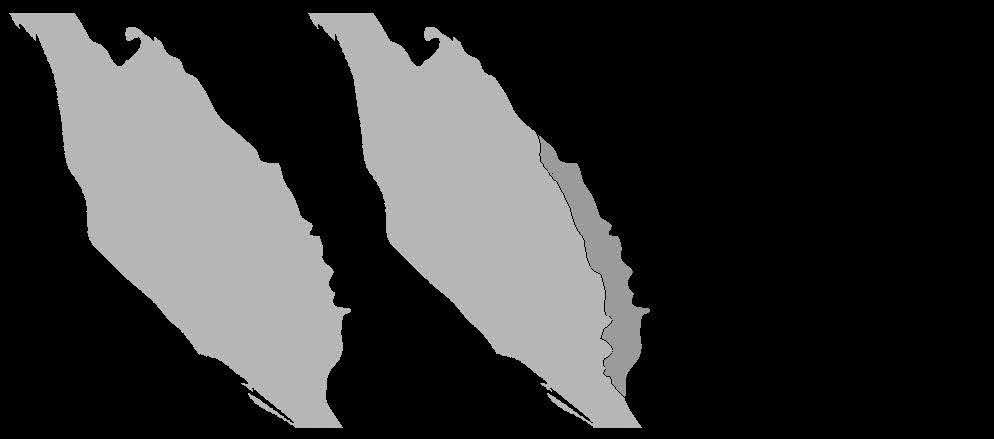
rapidly succumb to hydrolysis and become altered to clay minerals, particularly in the presence of plant-derived organic acids (eg. Velbel, 1990; Drever, 1994). In arid settings (such as the coastal interior adjacent to the Montney coast), rainfall is rare, typically catastrophic and short-lived and the paucity of plants minimizes the presence of organic acids in soils. Thus, the affects of hydrolysis were minimal in the Montney interior and mineral breakdown was dominated by mechanical influences (grain-grain interactions). Although clay minerals do occur in fine-grained Montney strata, much of this clay is immobile (occurring within individual degraded mica or feldspar grains). Large quantities of clay occur in only a few locations in the basin, such as Pedigree, Ring and Border fields on the Alberta-British Columbia border and Dixonville field in central Alberta.
As with all desert systems, wind plays an important role in sediment transport, particularly within coast-proximal areas. Finer-grained clastics (fine silt; <20 μ) may have been carried in suspension 10s to
hundreds of kilometres offshore, however medium to coarse silt and very fine-grained sand (20-125 μ) are transported primarily by saltation and are rarely transported more than a few 10s of metres in air (Nickling and Neumann, 2009; Bullard, 2009). Water, in the form of sheet floods and reactivation of ephemeral streams is the dominant sediment transport medium in desert systems (Powell, 2009). The Montney was no exception. Montney sediment delivery to the coast and broad ramp is attributed to numerous ephemeral rivers and a very few perennial rivers flowing from the craton interior to the northwest Pangaean coastline (Zonneveld and Moslow, 2014).
Montney beginnings.—The basal Montney Formation (Griesbachian / lower Induan) comprises an overall retrogradational succession deposited as part of a regional marine transgression. Montney sediment accumulation was not uniform across the basin. Depocentres occurred in faultinfluenced areas including the Peace River embayment (Fort St. John Graben, Dawson
(Continued on page 22...)
RESERVOIR ISSUE 3 • MAY/JUNE 2017 21
Figure 1: Evolving Montney Palaeogeography. Note the occurrence of rare perennial fluvial feeder systems (Ring-Pedigree and Dixonville deltas) as well as numerous, seasonally / periodically active ephemeral feeder systems. Note the occurrence of the Griesbachian ‘Claraia zone’, the Dienerian-Smithian Coquinal Dolomite middle member and the late Smithian ‘Altares’ member. These three units comprise the main bioclastic horizons in the Montney Formation. Based on numerous source’s cited in text.
TECHNICAL ABSTRACTS
(Continued from page 21...)
Creek graben, Webster Fault, etc…) and the Hay River Fault Zone (Ring-Pedigree fields with ~100 metres of Griesbachian sediment accumulation). A subaerially exposed ridge (Fig. 1) occurred on the western margin of the basin partially constraining basin circulation and possibly acting as a source of sediment during some intervals.
The basal Montney transgression proceeded from west towards east, onlapping progressively older Paleozoic units towards the Montney subcrop limit. During the Griesbachian the Montney Basin was constrained on the west by a regional high, referred to informally as the Meosin-Muinok high (Fig. 1; Orchard and Zonneveld, 2008; Zonneveld et al., 2015), which occurred in the same approximate location as the Permian Sukunka Uplift (sensu Henderson et al., 1997). Shallow marine sandstone units occur in the several parts of the basin, including on the northeast (deltaic units in the RingPedigree area) and east central parts of the basin (Panek, 2000; Zonneveld et al., 2010a; 2010b). The Lower Montney Formation includes two lower order sequences, with a maximum flooding surface occurring in mid-Griesbachian strata, and another in the early Dienerian, after which the Montney shoreline started to prograde westwards. A localized occurrence with abundant thinshelled bivalves (the ‘Claraia’ zone) occurs in west-central British Columbia. The top of the Lower Montney is placed at a regional sequence boundary that approximates the Dienerian-Smithian (Induan-Olenekian) boundary (Fig. 2).
Mid-Montney sequence boundary I.— The late Dienerian heralded the maximum westward progradation of the lower Montney shoreline. These shorelines are characterized by very fine- to fine-grained sandstone and bioclastic packstone / grainstone (Coquinal dolomite middle member) in the southeastern part of the basin (Markhasin, 1994; Mederos, 1995; Davies et al., 1997). Maximum progradation, and the Lower-Montney - Middle Montney sequence boundary occurred at the Dienerian-Smithian (Induan-Olenekian) boundary. This sequence boundary is most easily resolvable in the eastern Alberta subsurface, and in the Peace River embayment area where the Montney Turbidite Zone (occurs). It correlates with

Dienerian-Smithian
Montney
in Alberta. Unconformity 2 approximates the Smithian-Spathian boundary and is easily recognized throughout western Alberta and northeastern British Columbia. Unconformity 4 separates the Montney Formation from the Doig Phosphate Zone. Erosional outliers of the “Anisian wedge” erosionally overlie the Montney Formation (unconformity 3) and are erosionally overlain by the Doig Phosphate Zone (unconformity 4). Note the occurrence of the bioclastic packstone and grainstone beds of the ‘Claraia Zone’ and ‘Altares’ member.
a basinward correlative conformity in the western subsurface. This boundary coincides with early collision of Pericratonic terranes with the North American autochthon (Beranek and Mortensen, 2011). The early Smithian interval (earliest Olenekian) was characterized by marine transgression and retrogradation of Montney shorelines towards the east. Maximum transgression occurred during the mid-Smithian. The upper Smithian is characterized by strong progradation of the Montney shoreline towards the west. Indeed, during this interval the shoreline prograded further westwards than during the earlier Dienerian progradation. The upper Smithian also saw the occurrence of an interval of abundant sharp-based bioclastic grainstone beds within a siltstone matrix. This unit, informally referred to as the ‘Altares member’, is younger than other bioclastic intervals in the Montney Formation. Taphonomic and sedimentological criteria indicate some degree of transport in the genesis of this unit. A lack of bioclastic beds in temporally equivalent units in shallower settings suggests that the transport may have been local rather than regional.
Mid-Montney sequence boundary
II.— A second, major intraformational unconformity has been shown by
numerous authors (eg. Golding et al., 2014; Davies and Hume, 2016) to approximate the Smithian-Spathian boundary. This boundary has been identified throughout the basin, from outcrop in Kananaskis to the western subcrop in British Columbia. A phosphate pebble lag commonly occurs at the sequence boundary in southern and eastern sections, typically in association with a low-diversity Glossifungitesdemarcated discontinuity surface. In western and northern sections, this surface is informally referred to as the ‘Montney shoulder’ due to its appearance on well logs. It is demarcated in the western subsurface by a shift from interbedded bioclastic packstone / grainstone and siltstone in the Middle Montney to laminated phosphaterich siltstone in the Upper Montney.
Montney endings.— Overlying the laminated siltstone beds in the lower part of the upper Montney Formation, the unit grades upwards to interbedded waverippled and bioturbated siltstone. It is strongly progradational and interpreted to be a low-angle clastic ramp succession. The Upper Montney is erosionally overlain by younger, dominantly Middle Triassic (Anisian), strata. Commonly, the overlying strata are phosphate granule and gravelrich strata of the Doig Phosphate Zone. Recent work has shown that in some
22 RESERVOIR ISSUE 3 • MAY/JUNE 2017
Figure 2. Montney Stratigraphy, western Alberta to the subcrop limit, British Columbia. Unconformity 1 approximates the
(Induan-Olenekian) boundary and is a major
subdivision
parts of the basin, a distinctive unit of interbedded highly bioturbated and nonbioturbated sediment occurs between the Montney Formation and the Doig Phosphate Zone (Zonneveld and Moslow, 2015; Zonneveld et al., 2015; 2016; Furlong et al., 2016; Davies and Hume, 2016). This unit, informally referred to as the ‘Anisian wedge’ is not allied with either unit but comprises a distinct stratigraphic interval on its own (Zonneveld and Moslow, 2015; Zonneveld et al., 2015; 2016; Furlong et al., 2016).
Acknowledgements
Triassic research at the University of Alberta over the last 10 years has been supported by NSERC (Discovery grants and a CRD grant), and a variety of companies including Barrick, Birchcliff Resources, Canbriam Energy, Cequence Energy, Progress Energy Canada, Sasol Canada, Shell Canada, Talisman and Taqa North. Ideas herein have involved numerous individuals in academia and industry.
References
Beranek, L.P., J.K. Mortensen, M.J. Orchard, and T. Ullrich. 2010. Provenance of North American Triassic strata from west-central and southeastern Yukon: correlations with coeval strata in the Western Canadian Sedimentary Basin and Canadian Arctic Islands. Canadian Journal of Earth Sciences, 47: 53-73.Bullard, J.E. 2009. Dust. in Geomorphology of desert environments (Parsons, A.J and Abrahams, A.D., eds) p. 629-654.
Davies, G.R., Moslow, T.F. and Sherwin, M.D. 1997. The Lower Triassic Montney Formation, west central Alberta. Bulletin of Canadian Petroleum Geology, 45: 474-505.
Davies, G.R. and Hume, D. 2016. Lowstand/ Slope-onlap Wedge in the Montney: Stratigraphic and Sequence Framework, Reservoir Significance. GeoConvention 2016, Abstract, 4p.
Drever, J.I. and Vance, G.F. Role of soil organic acids in mineral weathering processes. In. Organic acids in geological processes (Pittman, E.D. and Lewan, M.D., eds.). Springer. P. 138-161.
Furlong, C.M., Gingras, M.K., and Zonneveld, J.P. 2016. Bioturbation influence
on reservoir quality: A case study from the “Anisian Wedge” of the Lower Triassic Montney Formation. British Columbia Unconventional Gas Technical Forum.
Markhasin, B. 1997. Sedimentology and stratigraphy of the Lower Triassic Montney Formation, subsurface of northwestern Alberta. Unpublished M.Sc. Thesis, University of Calgary, Alberta, 212 p.
Mederos, S. 1995. Sedimentology and sequence stratigraphy of the Montney Formation in the Sturgeon Lake A and B pool. Unpublished M.Sc. Thesis, University of Alberta, Edmonton, 229 p.
Moslow, T.F. 2000. Reservoir architecture of a fine-grained turbidite system: Lower Triassic Montney Formation, Western Canada Sedimentary Basin. In: Deepwater Reservoirs of the World, Conference Proceedings, Gulf Coast SEPM. (Weimer, P. et al., eds.). p. 686–713.
Nickling, W.G. and Neumann, C.M. 2009. Aeolian Sediment Transport in Geomorphology of desert environments (Parsons, A.J and Abrahams, A.D., eds), p. 517-555.
Panek, R. 2000. The sedimentology and stratigraphy of the Lower Triassic Montney Formation in the subsurface of the Peace River area, northwestern Alberta. Unpublished M.Sc. Thesis, University of Calgary, Alberta, 275 p.
Powell, D.M. 2009. Dryland rivers: processes and forms. in Geomorphology of desert environments (Parsons, A.J and Abrahams, A.D., eds) p. 333-373.
Velbel, M.A. 1990. Influence of temperature and mineral surface characteristics on feldspar weathering rates in natural and artificial systems: a first approximation. Water resources research 26: 3049-3053.
Zonneveld, J-P., Golding, M. Moslow, T.F., Orchard, M.J., Playter, T and Wilson, N. 2011. Depositional framework of the Lower Triassic Montney Formation, West-central Alberta and Northeastern British Columbia. 2011 CSPG CSEO CWLS Convention: Recovery, p. 1-4.
Zonneveld, J-P., Beatty, T.W. and
TECHNICAL ABSTRACTS
Gingras, M.K. 2010a. Diverse ichnofossil assemblages following the P-T mass extinction, Lower Triassic, Alberta and British Columbia, Canada: evidence for shallow marine refugia on the northwestern coast of Pangaea. Palaios, 25: 368-392.
Zonneveld, J.P., MacNaughton, R.B., Utting, J., Beaty, T.W., Pemberton, S.G. and Henderson, C.M. 2010b. Sedimentology and ichnology of the Lower Triassic Montney Formation in the Pedigree-Ring/ Border Kahntah River area, northwestern Alberta and northeastern British Columbia. Bulletin of Canadian Pet¬¬roleum Geology, 58: 115-140.
Zonneveld, J. P., Moslow, T.F. 2014. Perennial River Deltas of the Montney Formation: Alberta and British Columbia Subcrop Edge (Oral Presentation). GeoConvention 2014: May 12 – 16 2014, Calgary, AB.
Zonneveld, J.P., and Moslow, T.F. 2015. The Montney-Doig boundary and the ‘Anisian Wedge’’ in northeastern British Columbia. British Columbia Unconventional Gas Technical Forum.
Zonneveld, J.P., Furlong, C.M., Gegolick, A., Gingras, M.K., Golding, M., Moslow, T., Orchard, M., Playter, T., Prenoslo, D. and Sanders, S.C. 2015. Stratigraphic Architecture of the Montney Formation, Peace District, Alberta and British Columbia. William C. Gussow Geoscience Conference.
Zonneveld, J-P., Furlong, C.M., Gegolick, A., Gingras, M.K., Golding, M., Moslow, T., Orchard, M., Playter, T., Prenoslo, D. and Sanders, S.C. 2016. The MontneyDoig Boundary and the “Anisian Wedge”. Canadian Society of Petroleum Geologists: International Core Conference.
RESERVOIR ISSUE 3 • MAY/JUNE 2017 23
TECHNICAL ABSTRACTS
A VIRTUAL MCMURRAY FORMATION OUTCROP TOUR –AN EVOLVING TOOL FOR CHARACTERIZING OIL SANDS RESERVOIRS AND CREATING REALISTIC GEOMODELS
Rudy Strobl (Executive Director, EnerFox Enterprises)
Milovan Fustic (Adjunct Professor, U of Calgary)
Rob Davies (Director of Field Operations, Automated Aeronautics)
Unmanned Aerial Vehicles (UAV’s) are used to create high-resolution video, orthomosaic images and three-dimensional models for outcrops of any size or location. A virtual tour of the McMurray Formation type section (Figure 1), near the city of Ft. McMurray is presented, to show an example of a cost-effective and convenient method to characterize oil sands exposures for insitu and mining applications, in addition to creating an exciting new approach to creating data sets for sedimentological studies. Although virtual tours cannot replace actually visiting the outcrop in the field, they have the distinct advantage of illustrating and teaching reservoir analogues and depositional models within the safety of the classroom or office setting. High-resolution photographs geo-referenced with appropriate latitude, longitude and elevation are now available the study of the entire outcrop, and are particularly effective for areas that are steep or inaccessible, which often represents most of the outcrop. In many instances, high resolution detailed images could not be obtained before nor could accurate measurements be made before this new technology became available.
Field trip leaders will soon be using UAV ‘s simultaneously to complement field visits, to illustrate hard to steep or inaccessible portions of the reservoir, in addition to providing expanded views of the outcrop without the distortion associated with looking 30 to 60 m upward from the river level. These evolving tools help meet new economic realities and safety regulations for companies and universities.
The reader is invited to view a “fly-through” of the McMurray Type Section using UAV derived data by connecting to the

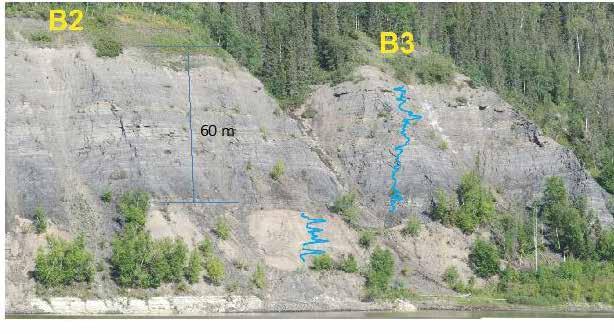
following YouTube link: https://youtu. be/7cm2INL7HC0
Detailed sedimentology, statistics on bed lengths, measurements of geological features and reservoir characterization over the length of the outcrop can now obtained with UAV derived images and data. The UAV’s can create detailed, highresolution images from several elevations at optimal distances from the outcrop face, with minimal distortion or interference by vegetation. Previous studies were limited
to side canyons where similar quality images could be obtained.
Integrated detailed studies of bowls B2 and B3 of the McMurray Type Section (Figure 2) illustrates how these two sources of data can be complementary. In this example, complementary data includes detailed measurements made by geologists who describe the sedimentology on a bed-bybed basis (5 to 10 cm scale) for the entire 7085 m thick section. Included in this study was a simulated gamma ray for comparison
24 RESERVOIR ISSUE 3 • MAY/JUNE 2017
Figure 1. McMurray Formation Type Section photomontage created from river level. This outcrop is approximately 60m high and 1.8 km long. An outcrop study by Fustic et al., in press, subdivides the outcrop into individual bowls, each with unique sedimentological characteristics.
Figure 2. Bowls B2 and B3 of the McMurray Formation Type Section, illustrating previous studies of I.H.S., regional water/bitumen contacts, lean zones and other important reservoir modeling parameters (Strobl et al., 2014).
to offset geophysical log data from core holes located approximately in the vicinity of the outcrop. These data can be compared to the larger context provided by the virtual tour UAV derived measurements.
UAV’s provide customized geo-referenced 3-d point cloud data. Recommended measurements for reservoir characterization purposes include the length and thickness of I.H.S., incising channel successions, mudstone-clast breccias and lean zones. Hundred’s of
measurements are now possible providing statistically valid data for modeling. Specific sedimentological data can be utilized by reservoir modeling and mapping software including familiar packages such as ArcGIS, Petrel, Roxar and GoCad.
References:
Fustic, M., Rudy Strobl, Martin Fowler, Bryce Jablonski, and Allard Martinius, in press, Field Excursion: Impact of Reservoir Heterogeneity on Oil Migration and the Origin of Enigmatic Oil-Water Contacts:
TECHNICAL ABSTRACTS
McMurray Formation Type Section, Alberta, Canada, in Outcrops that Change the Way That We Practice Petroleum Geology, American Association of Geologists.
Strobl, R.S., Milovan Fustic and Daryl Wightman (2015): The Athabasca Oil Sands Area from Basin to Molecular Scale - 4D Observations from Inside the Reservoir, Fort McMurray, Alberta, June 16 & 17, 2015, CSPG Field Guide, 41 pp.
CARIBOU: THE NEXT MONTNEY OIL SWEET-SPOT
Ian, J. Cockerill, TSV-TMK Montney
Summary
A fully integrated resource evaluation of the Montney Play in NE British Columbia has identified and high-graded the Caribou area (94-G-09) as having particular attributes to suggest significant recoverable oil and liquids potential in the Montney Play.
Using zone attribute analysis for 1,400 digital wells and a petrophysical interpretation
of 400 wells, the resource potenial of the Montney Play in NE British Columbia has been evaluated and quantified using a process called Common Recovery Segment Mapping.
The resultant mapping and resource evaluation has successfully predicted the emergance of oil zones in the Montney at Tower and Inga. By analogy and calibration to the proven oil sweet-spots of the play,
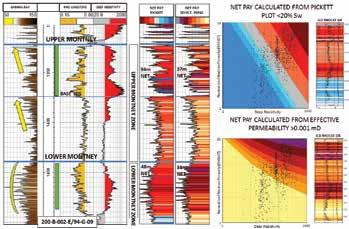
the geology in the Caribou area appears extremely prospective for oil in both the Upper and Lower Montney zones.
Acknowledgements
TSV-TMK Montney is a Joint Venture between TSV Montney and TMK Montney, both Australian based publically unlisted companies. This paper is presented with permission and the support of both companies.

RESERVOIR ISSUE 3 • MAY/JUNE 2017 25
Figure 1 – Example of Net Pay calculated from Pickett and Effective Permeability for well 200-B-002-E/94-G-09.
Figure 2 – Example of a Common Recovery Segment Map for the Lower Montney together with input mapping on the interpreted geological drivers for recovery, NE British Columbia.
THE LOWER TRIASSIC MONTNEY FORMATION: THE GROWING GIANT
Graham
R. Davies, Ph.D., P. Geol., Graham Davies Geological Consultants (GDGC) Ltd., Calgary, AB
Thomas F. Moslow, Moslow Geoscience Consulting Ltd., Calgary, AB
Introduction
The Lower Triassic Montney Formation in the WCSB has emerged within the last ten years or so as one of North America's top unconventional resource plays, after a long history (60+ years) of exploration and production in generally shallower 'conventional' reservoirs. The increasing focus is on areas that are overpressured, sweet, and liquids-rich (Nevokshonoff, session abstract, 2017), ranging from the Karr-Kakwa area in west-central Alberta, to increasingly northward in northeastern BC (NE BC). The geographic extent of the play is in the order of 130,000 square kms, extending at least 560kms from north to south, to ca 220kms east-west (modified from Jarrah, TD Security, Jan. 2017), with more than 5600 wells in the Montney in Alberta and BC as of 2016 (ibid.). With longer horizontals and larger fracs, and increasing sophistication of horizontal well localization in condensaterich intervals, the per well costs and production economics continue to improve.
Regional Montney Stratigraphic Framework
One of the persistent geological issues that causes some confusion in assigning horizontals in the Montney to specific stratigraphic intervals, and in comparing wells in different field areas, is the lack of a consistent terminology for formation subdivisions on a regional scale. In one of the earlier contributions to Montney stratigraphy (Davies et al, 1997), based mainly on Alberta well and core control to about the mid-1990s, only Lower and 'Upper' Montney subdivisions were recognized. Since that time, with an exponential increase in Montney well penetrations and major extensions into NE BC, and guided by comparisons with global Lower Triassic sequences (Embry. 1997) and more recently by conodont dating of the Montney in NE BC (Moslow
et al, 2016), it is clear that there are three major unconformity-bounded sequences or subdivisions in the Montney. These now are recognized as the Lower, Middle, and Upper subdivisions. Adding some complication to this three-fold framework is the presence of two prominent westward-thickening lowstand wedges, at the base of the Middle and Upper divisions, respectively. Although today of little exploration interest (but a significant target of earlier 'conventional' exploration), the boundary between the Lower and Middle subdivisions of the Montney closer to the eastern subcrop edge of the formation is overlain by a thick, extensive and erosionally-based dolocoquina (Davies and Sherwin,1997).
One attempt to resolve regional Montney stratigraphic correlation issues is in preparation (Davies et al, in prep.) for the upcoming BSPG Special Volume on the Montney. This contribution is built around a long log-based but coregrounded NNW-SSE cross-section from the Karr-Kakwa area in west-central Alberta to beyond the northern boundary of the Peace River area in NE BC. In the latter area, the section ties into conodont dating of the Montney by Progress Energy (Moslow et al, 2016, and in prep.). A correlative sub-project in planning phase aims to date the subdivisions of the Montney in the Karr-Kakwa area, again using conodonts. If that objective is met, both 'ends' of the regional NNW-SSE section will have a consistent conodontbased biostratigraphic framework, perhaps allowing it to become an industry reference standard (or at least a basis for such a standard). Collaborative efforts to better define the chronostratigraphic framework and paleogeographic evolution of the Montney are currently underway by teams of researchers at the University of Alberta under the direction of Professor John-Paul Zonneveld, and
at the University of Calgary under the direction of Professor Charles Henderson.
Montney Technical Session at CSPG Conference
There will be several Montney sessions at the 2017 GeoConvention, reflecting the high industry interest in this target. The session chaired by Graham Davies and Tom Moslow is titled" The Montney: the growing giant". It includes presentations from leaders in their fields, from innovative exploration and development, to leading-edge researchers in academia. Topics range from new insights on the paleogeographic setting of the Montney, to northern extension of the play in NE BC, to the current state of play in the KarrKakwa area of west-central Alberta, and to presentations on impact of secondary migration of methane on hydrocarbon fluid distribution, significance of rapid changes in liquid to gas ratios and liquid geochemical signatures, and elastic anisotropy characteristics of tight Montney siltstones.
Conclusion
Although it is a world-class unconventional resource play, the Montney, like many other units in that category globally, still contains facies-dependent sweet spots that need to be understood geologically, geochemically, geomechanically and otherwise, and to be targeted with everincreasing precision and cost-effective engineering design. As long as global oil prices retain a degree of stability, or increase, the Montney will continue to grow in economic significance to western Canada, and to Canada as a whole.
(Continued on page 30...)
26 RESERVOIR ISSUE 3 • MAY/JUNE 2017
SESSION HIGHLIGHTS
“GLOBAL CARBON CAPTURE, STORAGE, UTILIZATION AND MONITORING”
By Luc Rock & Kirk Osadetz
Interested in Greenhouse Gas reduction technologies and opportunities? Then the full-day session on May 16th called “Global Carbon Capture, Storage, Utilization and Monitoring” at this year’s GeoConvention is for you.
Canada is a global leader in the field of Carbon Dioxide Capture, Storage and Utilization (CCSU). The stratigraphic history of the Western Canada Sedimentary Basin is uniquely endowed with the fossil energy resources that motivate the need for industrial carbon management, and also provides one of the world’s best opportunities for carbon dioxide storage in geological media. It also includes possible novel storage opportunities for carbon dioxide as a solid gas hydrate in the Athabasca region. Canada is home to two of the world’s leading CCSU projects including Shell’s fully integrated Quest CCS Project (capture, transport, storage, monitoring), and the combined capture, enhanced recovery and storage project at Boundary Dam, Weyburn and Aquistore in Saskatchewan. These are among the earliest, largest and most successful industrial CCSU projects globally.
During the morning session, we are delighted to showcase presentations by the International Energy Agency Greenhouse Gas R&D (IEAGHG) Programme, as well as pioneering industrial scale projects from around the globe covering Norway, US, and Canada:
James Craig (IEAGHG) presents on “Current Status of Carbon Capture and Storage: challenges and future prospects”; Britta Paasch (Statoil) et al. present on “Industrial-scale CCS in Norway: experience gained and application to future projects“ ; Scott McDonald (Archer Daniels Midland Company) presents on “The Illinois Industrial Carbon Capture & Storage Project: Eliminating CO2 Emissions from the Production of Bio Fuels - A ‘Green’
Carbon Process”; and Simon O`Brien (Shell Canada) will give a presentation on ”Overview of Shell CCS projects”.
In addition, the topic of CO2 utilization within the oil industry will be addressed, with talks by:
Kirk Osadetz (Carbon Management Canada) et al. on “Opportunities and Challenges for the use of Improved and Enhanced Conventional Petroleum Recovery in GHG mitigation strategies”, and Murray Reynolds (Ferus Inc.) on “Value Added Usage of Anthropogenic Carbon Dioxide in Oilfield Operations – New Applications in Unconventional Reservoirs”.
Safe storage depends on an effective repository and monitoring. Greenhouse Gas management projects, such as Carbon Management Canada (CMC) Research Institutes’ Field Research Station (FRS) that studies subsurface project conformance and storage complex containment, have applications beyond CCSU. This includes steam chamber cap-rock integrity, subsurface disposal, induced hydraulic fracturing, and groundwater and environmental protection. Hence, during the afternoon session, you will learn about monitoring technologies relevant to Greenhouse Gas management from case studies (including PCOR, Aquistore and Quest), and state-of-the art research activities undertaken at CMC Research Institutes’ FRS near Brooks, Alberta.
The first part of the afternoon session includes a series of talks related to FRS by:
Don Lawton et al. (CMC) on “Monitoring technology innovation at the CaMI Field Research Station, Brooks, Alberta“; Nicholas Utting (CanmetENERGY Natural Resources Canada) et al. on “Noble Gases as a Tracer of Subsurface Processes at CMC Research Institutes Field Research Station”; and
Samuel Krevor and Olivia Sloan (Imperial College London) on “Capillary limited flow behaviour for subsurface CO2 injection at the CMC Field Research Station”.
To round off the afternoon session a series of case studies focused on monitoring will be presented, covering the Plains CO2 Reduction (PCOR) Partnership, Aquistore, and Quest:
Neil Wildgust et al. (Energy & Environmental Research Center) present on “Demonstration of Secure CO2 Geological Storage in the PCOR Partnership Region”; Erik Nickel (Petroleum Technology Research Centre) et al. on “Integrated monitoring systems at the PTRC’s Aquistore field laboratory: More than just a CO2 storage project”; and Luc Rock (Shell Canada) on “Quest CCS project’s MMV program: overview and 1st year review post start of injection”.
Please join us May 16th in Glen Room 205 for the full-day session called “Global Carbon Capture, Storage, Utilization and Monitoring”. An opportunity not to be missed for learning about Greenhouse Gas reduction technologies and opportunities with a local and international flavour.
In conjunction to the full day session on “Global Carbon Capture, Storage, Utilization and Monitoring”, a field trip is being organized on May 11th, called “Progress and Challenges for CCUS in Alberta and Canada”. One of the objectives of this field trip is to introduce participants to recent research and commercial demonstrations of CCS technology in Western Canada, with an emphasis on the FRS and Quest projects, but mentioning others. The trip will also discuss aspects, indicators and impacts of the changing climate on the Palliser Triangle, where the FRS is located.
RESERVOIR ISSUE 3 • MAY/JUNE 2017 27 SESSION HIGHLIGHTS
HIGHER LANDING CAREER BRANDING SESSION
By Jackie Rafter
Here’s the bottom line: North America’s energy sector is in the midst of a paradigm shift. Career management has changed. Job search has changed. Forever. To thrive in 2017, you MUST know how to communicate your value in a way that truly separates you from the pack.
If you don’t know what makes you exceptional, how can anyone else? This important workshop is your essential first step to prepare yourself to LAND HIGHER. Know who you really are and learn how to effectively brand yourself and articulate your value proposition. Find out how to start building your brand by knowing, believing and sharing what makes you extraordinary and learn the secrets of standing out to strategic prospects.
Discover the secrets to our 80% landing rate in one of North America’s toughest economies and brand yourself for the 2017 job market.
At our personal career branding workshop we’ll teach geoscience professionals how to:
• Build their brand for the 2017 job market.
• Identify transferrable skills.
• Define their “secret sauce” and how to take that to market.
• Understand what sets them apart.
• Show them how to test their brand in the “Grizzly Den”… and much more.
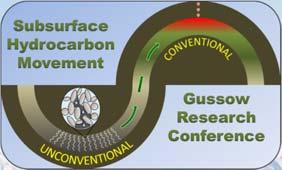
Also, if you think the Dragon’s Den is entertaining, wait until you see geoscientists pitch themselves to a live panel of influential business leaders to land their dream jobs at our live GRIZZLY DEN! Don’t miss this unique opportunity to learn what decision makers are looking for when assessing the unique brand value and marketability of a geoscientist.
Plus, you can join the fun with interactive audience voting!
And we are we are proud to partner with SMART Technologies who will take the Grizzly Den to whole new level with the latest smartboard technology to involve YOU – the audience!
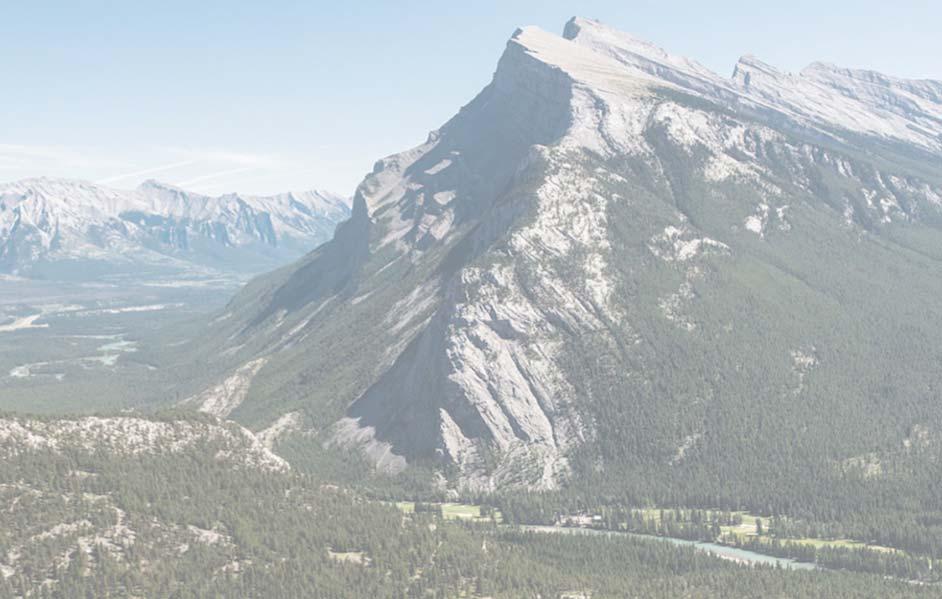
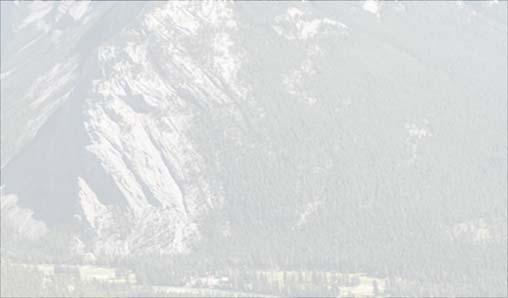
28 RESERVOIR ISSUE 3 • MAY/JUNE 2017
SESSION HIGHLIGHTS Subsurface Hydrocarbon Movement: Conventional to Unconventional Banff, Alberta, Canada | October 10-12, 2017 Registration includes Conference Accommodations 2 breakfast, 3 lunches Ice Breaker Conference Dinner Early Bird Ends June 15, 2017 CSPG Members $950 CAD Non Members $1250 CAD To view the technical program and to register go to www.cspg.org/gussow2017 This year's Gussow Research Conference aims to address the holy grail of petroleum systems research! We welcome a panel of expert speakers covering the physical principles of petroleum migration, geochemical (biomarker and isotope) tools, laboratory experiments, numerical simulation, and case studies. 5 diverse sessions of world-class lectures and discussion will address petroleum migration from pore to basin scale, reservoir leakage, and entrapment in tight oil plays.
SESSION HIGHLIGHTS
MODERN GEOSCIENCE PANEL
Emily Duncan & Karl Mome
The idea of the “Modern Geoscientist” was first introduced as a discussion topic during the panel session held at the Junior Geophysicist Forum (JGF) in late 2016. As part of that JGF panel, I enjoyed answering questions, sharing stories and advice, as well as hearing from the other panel members’ perspectives. What I more importantly noticed, was what an incredibly enriching experience it was for all participants in the audience and on the panel. The participants included students, junior CSEG members as well as our more experienced members and mentors. The collective need to share, collaborate, investigate, grow, and nurture was evident. Following the panel’s acclaim, the idea was brought forward to hold a panel that would expand the focus from Geophysicist, to the Modern Geoscientist during the 2017 Geoconvention. I am honoured to have been asked to be part of an event that diversifies the content of the convention itself as it is key in securing the success of such a dynamic industry, especially during a downturn. I believe the strength in our community of Modern Geoscientists is built on the personal relationships that we hold with one another, and our ability to collaborate on issues and/or share our knowledge with each other, whether it be technical knowledge or the “soft skills”. Participating in panels such as this one, as a panel member or as an audience member, encourages the personal relationships and knowledge sharing that we need in challenging times and in good times so that we can continue to work together to grow the geoscience industry in a conscientious and effective manner.
My experience as a geoscientist started when I was a child with my incessant need to collect rocks. I am certain I am not alone in this one. As a university undergraduate, I originally started off in Kinesiology as I hadn’t even heard of geophysics at the time. Part way through university, I switched my degree all because of one discussion with one Geophysics professor (Gail Atkinson), and delved into the Earth Sciences at the University of Western Ontario. Studying
under professors Dr. David Eaton, Dr. Guy Plint and several others, I received my first experiences with Modern Geoscientists as teachers and researchers. I had summer work terms with GEDCO and PanCanadian, at times when the oil price was $12/bbl, and oil and gas exploration geophysics was advancing through the work of Andreas Cordsen on 3D seismic survey design and through Bill Goodway’s work on Lambda Mu Rho. During my first full time position at BP Canada, and then later at 4th Wave Imaging in California, I worked Coal Bed Methane, technology teams, and software development. Following that, I spent time working with small to intermediate companies as a geophysical consultant, and then later as a staff member/shareholder. We also were forced to comprehend the importance of communications. Specifically while undertaking merger and acquisition work or presenting to shareholders/potential investors, I quickly understood the impact that our words and presentations could have with particular audiences. Following that, I worked internationally in Egypt and experienced the second downturn of my career: the collapse of the Trusts in 2008 and my first layoff.
I decided to re-train as a Master Yoga Instructor and follow that passion, which required a move to Vancouver. So, I adapted to my environment and was therefore a geoscientist no longer. I returned to Calgary in early 2011, and was approached by an old university friend about a geophysics position at Cenovus. This would be my third time being recommended for a job because of personal relationships, which I still find has a degree of ‘right place at the right time’ (a.k.a. luck). This time it was different, technology had changed vastly since I had last paid attention. Inversion was all the rage, new and sophisticated software had emerged….and all of a sudden I became aware of the need and expectation to quantify interpretations and change my outputs to integrate and collaborate with other disciplines. My journey to this awareness is completely attributed to the
very talented geophysicists like Jeremy Gallop, John Parkin, Marc Boulet and Jessica Galbraith all who were at Cenovus at the time. I also started participating in investigations into survey design and processing sequences with Ann O’Byrne and Jillian Dalsin and several individuals at CGGVeritas. I had become a Modern Geoscientist. Then along came an old colleague of mine who had moved to Suncor, and he asked me to move over (Literally across the street). I had always been interested in the In Situ world, and now here I am, entering my fourth year with Suncor’s Emerging Projects team for In Situ all while surviving the third economic downturn of my career! Somehow this is the busiest job I have ever had and this is the most engaged I’ve ever been. Part of that engagement includes seeing how I can pay it forward within our Geoscience community.
When I accepted the position of Panel Chair, I immediately started to think of who I would ask to join the panel. I chose people who I thought would contribute different perspectives and varying life/ career experiences.
Karl Mome is our most junior member and is a former geophysical summer student of mine from Cenovus. He was the chair of the CSEG Junior Geophysicist Forum in 2015 and 2016 and is the reason I was involved in that first panel. He has passion to discuss the issues from a junior geoscientist’s perspective as he is currently a G.I.T. at Cenovus. I especially appreciate his internal drive as an individual to always be proactive in his career and development. This includes his huge move north from California to pursue his dreams of working in the oil industry, and his various volunteer activities. Dean Potter is our most senior member of our panel and he caught my attention as a geoscientist that was serving in the investment community. I reached out to him for his work with a private equity firm, and later learned of his diverse background
(Continued on page 30...)
RESERVOIR ISSUE 3 • MAY/JUNE 2017 29
(Continued from page 29...)
and long career of over 35 years of experience in the oil and gas industry. This includes leading three start-up private oil and gas companies, one of which is still on the go. Dean’s background enables him to bring a historical and a longer-term view of the industry. Representing the educational side is Dr. Paul Durkin. I met Dr. Durkin outside of the oil and gas industry through music and camping as he is well-known for his lead vocals in a local band: Clutch Jennings. Paul is recognized in industry for his research on fluvial meander-belt processes with Dr. Stephen Hubbard. As he takes on the next part of his career journey as a professor at the University of Manitoba in early 2018, his passion for utilizing technology such as drones to improve on our outputs from traditional mapping techniques is what brings him to the panel. He also is no stranger to traveling/moving for his passions and career. Laurie Bellman is renowned for her work in quantitative interpretation in the oil and gas industry. Her curiosity and quest for the most correct representation of the subsurface through data conditioning, seismic inversion techniques, quantitative interpretation and software development for interactive classification of data is what drives her business, Sound QI. Laurie and I met through a CSEG workshop on
5D interpolation when I asked her advice on giving talks as she has such a talent for communication of intricate technical geoscience subjects to non-experts. She has recently been celebrated as the CSEG Distinguished Lecturer of 2017. Interestingly, one of the first times I met David Gray was at that same workshop on 5D interpolation. He and Laurie worked together at Nexen for a while, and I later got to know him through Suncor’s partnership with Nexen on an in situ property as he serves as a Senior Geophysical Advisor there. David is a prominent member of our geophysics community and is very wellknown for several technological advances in geophysics in quantitative interpretation, seismic fracture identification and seismic geomechanics and was recently recognized for the tremendous value he has added to our geoscience community by being the honoree of the 2015 CSEG Symposium. He brings to the panel a desire to address the remarks that are made on our industry from an environmental and sociological perspective.
The panel had its first meeting in midMarch where we came up with several themes for discussion around the Modern Geoscientist, there will be a short 10-
SESSION HIGHLIGHTS
15 minute presentation on several of the topics by various panel members. Following each short presentation, there will be a discussion period. The format of the session will enable direct interaction of the audience with the panel following each presentation, via text or live (microphone) questions. The themes that we are planning to address include: Adaptation, Initiative, Passion, Communications, Demographics, Collaboration and Luck. Each theme has multiple possibilities for topics, and the discussions will be influenced by the presentations and led by the questions from the audience.
I look forward to sharing this time with the tremendous panel members that have volunteered to share their experience and perspectives with us. I encourage you to join us and participate through offering your thoughts and experiences and questions for the panel or just holding the space and being present for these important discussions. Let’s work together to continue to move our science and community forward so that we are the most effect Modern Geoscientists that we can be and so that we continue to develop that niche for the Future Geoscientists.
(Continued from page 26...)
References:
Davies, G.R., Moslow, T.F., and Sherwin, M.D., 1997, The Lower Triassic Montney Formation, west-central Alberta. Bulletin of Canadian Petroleum Geology. v.45. no.4, p.474-505.
Davies, G.R., and Sherwin, M.D., 1997, Productive dolomitized coquinal facies of the Lower Triassic Montney Formation, Western Canada Sedimentary Basin. CSPG-SEPM Joint Convention, Calgary, Core Conference guidebook, p. 257-276.
Embry, A.F., 1997, Global sequence boundaries of the Triassic. Bulletin of Canadian Petroleum Geology, v. 45, no,4, p.415-433
Jarrah, J., 2017, Montney potential continues to grow: NEB Initial Resource
Assessment likely to rise. TD Securities Inc., presentation to US investors. Daily Oil Bulletin, Jan.10, 2017
Moslow, T.F., Haverslew, B. and Henderson, C. M., 2016, Sedimentary facies, conodont biostratigraphy and reservoir quality of a continuous (395m) full diameter core of the Lower Triassic Montney Formation, northeastern British Columbia, Western Canada. CSPG International Core Conference Abstract Booklet, p.71-78.
30 RESERVOIR ISSUE 3 • MAY/JUNE 2017
INTEGRATING GEOSCIENCE TO OPTIMIZE UNCONVENTIONAL AND OILSAND RESOURCE PLAYS SESSION
By Allan Turner
When we think of geoscience, the oil industry, or even just science, the word “creativity” is not likely the first to come to mind. Creativity, however, is the common theme in this session, and truly underlies the need for science, in general, and geoscience in particular, to keep advancing into creative areas. We can think of this session as divided into three categories: using conventional methods to develop innovative interpretations; the repurposing of existing and developing technologies to answer complex geological and geographical environments; and the use of cutting edge technologies to create predictive determinations, thereby unearthing previously unforeseen opportunities.
Through repurposing hyperspectral technology, Rivard et al. from the Department of Earth and Atmospheric Sciences, University of Alberta, discuss the multifaceted uses it can provide in “Characterization of tight shales from hyperspectral imagery of drill core”. The ability to use this technology in shales to perceive sedimentological features that are not visible to the naked eye, view boundaries between formations, and perform geochemical and mineralogical analysis can rapidly provide critical information that can steer the development of the resource.
Steam chambers in the San Joaquin Valley, California are observed to have high gamma ray values through intervals of hot, vapour filled rock, following steam injection at temperatures above 250°F. In the presentation “High Gamma Ray in the Steam Chamber: A New Method for Continuous Observation of the EOR process”, O’Sullivan from Vapor Condensation Technologies LLC,
shows how traditional geoscience tools, specifically the interpretation of gamma ray readings, can be effectively used to observe and optimize enhanced oil recovery (EOR) processes.
The need to advance fracture prediction methods in the Second White Specks Formation lead Marion and Cheadle from the Department of Earth Sciences, Western University, to assess the predictive capacity of using mappable petrophysical attributes in areas with low quantities of mineralogical core analyses. In their presentation “Solving the Second White Specks: Integrating petrophysics and allostratigraphy to find sweet spots” they review the development of a mineral model, calibrated to core control, that approximates the relative brittle behavior of the Second White Specks and Belle Fourche alloformations. The methods developed in this study may prove invaluable in identifying naturally fractured prospective zones.
Many of us know these tools as drones, but UAVs (unmanned aerial vehicles) have more than just military or recreational uses. Strobl et al. of EnerFox Enterprises, in collaboration with the University of Calgary and Automated Aeronautics, examine the use of UAVs as exploration and training tools in “A Virtual McMurray Formation Outcrop Tour – An Evolving Tool for Characterizing Oil Sands Reservoirs and Creating Realistic Geomodels”. In addition to using UAVs for mapping remote or difficult to access areas, or as precursors for exploration of areas that have limited accessibility, this technology can also be used as an economic, accessible, and safety conscious complement to field visits for industry, academia, and government agencies.
A fresh perspective on the determination
of rock mechanical properties is shown through integrating sedimentary fabric and structural information from outcrop and core studies. Hill and Pederson from the Department of Geoscience, University of Calgary, present the results of a study that assessed the natural fractions identified in 266 cores in “Sedimentary fabric control on hydraulic fracture stimulation, tight light oil sandstone reservoirs of the Cardium Formation SW Pembina Field, western Alberta”. The results from this study support that sedimentary fabric has a stronger influence than the interval composition on hydraulic fracture stimulation parameters in light oil, tight Cardium shoreline reservoirs.
How does the adaptation of predicative algorithms used by evolutionary biologists relate to geoscientific explorations? Paiement et al. from SGS Canada Inc., discuss the repurposing of these algorithms in “Artificial intelligence for mineral and chemical stratigraphic correlations” into new and innovative usages, thereby showcasing the importance of crosscollaboration between disciplines. The A.I. manipulates multiple datasets on a massive scale, looking for trends, then winnows the data down into a manageable form for the human user.
Technology in and of itself is a powerful tool, and in removing the cone of separation between geoscience and other sciences, we have opportunities to share innovations, leading all scientific disciplines into interesting and potentially revolutionary directions. The need for creative solutions within the Unconventional and Oilsand resources has never been more important. This session is a must for those in the industry looking for new, exciting perspectives on traditional resources.
RESERVOIR ISSUE 3 • MAY/JUNE 2017 31 SESSION HIGHLIGHTS
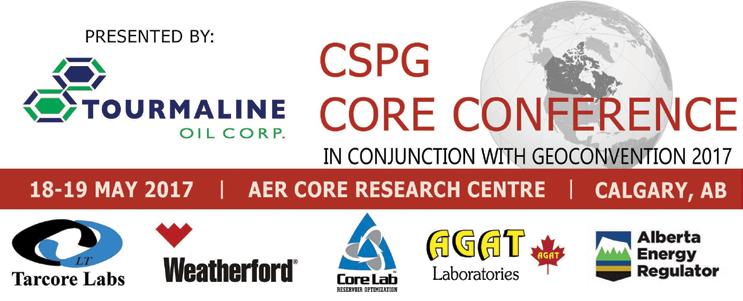
also enhance the Core Conference experience. Exhibitors provide scheduled talks summarizing their displays and remain with their core to discuss concepts and features. Displays will include both conventional and unconventional plays; siliciclastics, carbonates and evaporates, shales, oil sands, as well as some displays relating to carbon capture technology. We hope you will extend your stay in Calgary to attend this two-day post GeoConvention 2017 on May 18th & 19th, 2017!
Registration Rates:
General Delegate Registration: $175.00
*Core Meltdown ticket included
Core Presenter Registration: $150.00
*Core Meltdown ticket included
In-Transition Registration: $150.00
*Core Meltdown ticket included
***You must be a CSPG In-Transition Member to register at this price
Bulk Registration
3 x General Registration
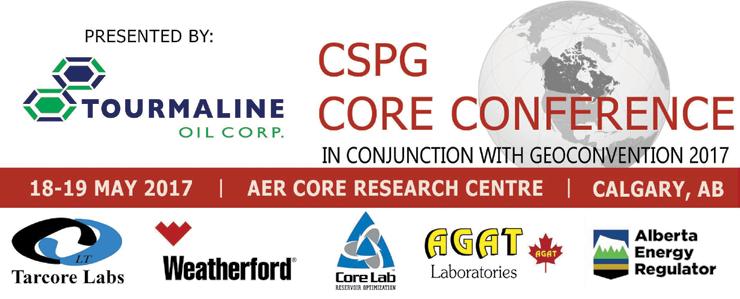
$ 375.00 ($50 savings per person)
5 x General Registration $ 500.00 ($75 savings per person)
Core Meltdown Ticket*: $ 25.00

Thank you to our sponsors!

ADVANCED REGISTRATION ENDS MAY 5TH* *On-site registration will be available
CORE CONFERENCE 2017: GRAND TOUR OF THE WESTERN CANADA SEDIMENTARY BASIN
Kelty Latos, CSPG Core Conference Committee member, ConocoPhillips
Introduction
The 2017 CSPG Core Conference has compiled its final abstract list, and the sessions are starting to take shape. Presenters this year include representatives from the best geoscience university programs in Canada as well as industry personnel who have seen the evolution of the basin over decades. The technical program spans the range of activity in Alberta, Saskatchewan, BC, and the Northwest Territories, from prolific unconventional plays such as the Horn River and Montney, to reservoir heterogeneity in the oilsands (pre-and post steam displays), to regional variations in tight sand unconventional plays such as the Viking and Spirit River. Over twenty-five distinct presentations will be on display, filling the space generously provided to us by the AER.
Montney
With 4bcfe/d, the hybrid Montney play is the most productive gas play in Canada, with 606 Montney wells drilled in 2016 alone. Three Montney core presentations will examine chemostratigraphy of the Anisian wedge, a detailed petrophysical analysis applying rock data to regional mapping, and a live demonstration of portable X-Ray Fluorescence instruments which can be used to better evaluate reservoir properties to better understand better and worse rock quality.
Viking
With over 6200 wells, the Viking is one of the most active plays in the WCSB. Shifting relative sea level and decreasing accommodation to the eastern edge of the basin leads to much stratigraphic complexity. Three Viking core presentations will examine this complexity, from a forced regressive asymmetric delta in the KaybobFox Creek Field, as well as two display close to the most actively drilled Viking fields, the falling stage and lowstand deposits at Judy Creek on the Saskatchewan/Alberta border, where facies characterization is crucial for understanding reservoir quality

in low permeability sandstone and muddy sandstone.
Spirit River
With some of the highest IP rates in the basin, exploration and development is active in the Spirit River (Wilrich/Falher), the highest hydrocarbon producing zone in the WCSB. Two cores will be on display one of which will examine the relationship between conventional and unconventional Spirit River development in the Elmworth field focusing on sequence stratigraphy, accommodation, reservoir quality, and chemostratigraphy. The second core display will show contrasting tight sandstone reservoirs in the Wapiti-Kakwa area, the Falher F and the Falher G (Upper Wilrich), characterized by deltaically influenced progradational shoreface successions.
Horn River
Exploration activity must still take place even when the industry is in a slump in order to create future potential to sustain the world's need for hydrocarbons. Although the Horn River Group is significantly challenged by lack of infrastructure, there is much potential and much geological understanding yet to be achieved. Two Horn River group cores will examine proposals for new lithostratigraphic units within the Horn River Group as well as continue progressing understanding of the sequence stratigraphic framework of this basin fill succession.
Oilsands
Although many companies have been required by SEC rules to write off significant reserves in the oilsands, with improving oil price these reserves will return to the books in the near future. Geological understanding of the oilsands has not halted however, and this year's core displays will examine both pre and post steam cores of the McMurray and upper McMurray to understand the impact of reservoir heterogeneities (such as inclined heterolithic stratification) on steam dynamics. Understanding of various Athabasca and McMurray paleovalleys and parasequences, even ones that are not currently prospective for bitumen, can shed insight into the overall regional depositional and stratigraphic history.
And much more
The carbonate legacy of the WCSB will be represented by four core displays of Debolt, Slave Point, as well as Ordovician & Mississippian carbonates from Saskatchewan. Other displays will include two Belly River displays, one on CO2 monitoring and one examining the Bearpaw transgression. One of the most unique displays will characterize the overburden in oilsands areas, focusing on glacially reworked material in shallow insitu bitumen areas.
With twenty-six displays, this year's core conference is poised to fill the space (Continued on page 34..)
RESERVOIR ISSUE 3 • MAY/JUNE 2017 33 CORE CONFERENCE
(Continued from page 33...)
generously supplied by the AER. Once again, the AER is allowing the CSPG to use its entire facility for the Core Conference.
The AER Core Labs is a one of a kind, world class facility, the existence of which has led to so many innovations in the Western Canada Sedimentary Basin and beyond.
Geoscientists in Alberta are very fortunate to have such a wealth of core data available to us at a reasonable price.
Each core will be on display for the two days of the Core Conference, during which the presenters will be on hand to discuss their core. As well, each presenter will deliver a short presentation outlining the key features of the core as well as their conclusions. The format allows for a significant amount of interaction with the leading minds of the Canadian petroleum geoscience community.
Please make the time on your calendar to attend this world-class event, where you can see hundreds of meters of core, network and enjoy the company of colleagues, and celebrate the never-ending puzzles our industry gives us to solve. As Wallace Pratt wrote: "Gold is where you find it, according to an old adage, but judging from the record of our experience, oil must be sought first of all in our minds."
CSPG is a not-for-profit corporation registered under the NFP Act. Our mission is: To advance the professions of the energy geosciences - as it applies to geology; foster the scientific, technical learning and professional development of its members; and promote the awareness of the profession to industry and the public.
Directors hold office for two years; commencing January 2018. Nominations for Directors close September 14 th, 2017.
CSPG is calling for nominations for the Executive Committee:
President Elect – who will continue to serve a total of three (3) years comprised of the first year as President Elect, the second year as President and the third year as Past President.
Finance Director Elect – who shall serve a two (2) year term comprised of the first year as Finance Director Elect and the second year as Finance Director
Two Directors At Large – each year CSPG elects Directors to fill portfolios. For 2018, CSPG is interested in attracting two new Directors. Please express your interest on the Nomination form.
Please note that only FULL Members of CSPG can be nominated
The Nomination Process: Nomination forms are available on www.cspg.org/Society/Governance
CSPG Nominating Committee recruits for potential directors. You may submit your nomination for their consideration. Alternatively, if you support your nomination with 25 Full Member signatures, you can stand for election. The Nomination form and Nomination Signature form must be submitted by September 14th, 2017 to Lis.Bjeld@cspg.org to the attention of Past President. Please
34 RESERVOIR ISSUE 3 • MAY/JUNE 2017
CORE CONFERENCE
direct any questions to Lis Bjeld, CSPG Executive Director at 403 -513-1235

TECHNICAL PROGRAM
Theme
Carbonates
Unconventional
Presentation Title
Author
Estimating the Probability of Encountering Favorable Porosity and Permeability in Devonian Dolostone Reservoirs near the Peace RiverArch, Northwestern Alberta John Dunham
Similarities in Ordovician and Mississippian Carbonate Sedimentation in the Williston Basin of Southeast Saskatchewan John Lake & Arden Marsh
Lodgepole Formation Souris Valley Beds: A New Approach to Describing Fine-Grained Sedimentary Rock in Core
The Mississippian Debolt Formation: Carbonate Bitumen Reservoirs of the Peace River Deposit
Reef to Off Reef Facies of the Upper Devonian Leduc and Duvernay Formations, Redwater Alberta
Scott MacKnight & Stephen Bend
Michael Ranger & Hans Machel
Pak Wong, John Weissenberger & Murray Gilhooly
Montney - From the Rock to the Log Godfried Wasser & Dana Kinnaird
Calciturbidites and Calcitempestities in the Duvernay, Distal Montney and some Black Shale Analogues
Sedminentological and Ichnological Analysis of the Montney Formation within the Pouce Coupe Area, Alberta
Cores from Black Shales Telling Rich Story: Stratigraphic Framework and Sedimentary Environments of the Horn River Group of Mackenzie Valley, North West Territories
Framing Mudrocks of the Hare Indian and Canol Formations (Horn River Group, Central Mackenzie Valley) in a Sequence Stratigraphic Context using High -Resolution Chemostratigraphy
X-Ray Fluorescence and Spectral Image Core Analysis in the Montney Formation: An Interactive Demonstration
Jean-Yves Chatellier, Jamil Afzal, Amjed Cheema & Carolyn Currie
Carolyn Furlong, Murray Gingras & John-Paul Zonneveld
Pavel Kabanov, Wing Chuen Chan & Sofie Gouwy
Maya LaGrange, Brette Harris, David Herbers, Mike Ansell, Kathryn Fiess, Viktor Terlaky & Murray Gingras
Thomas Weedmark, Ronald Spencer & Justin Besplug
RESERVOIR ISSUE 3 • MAY/JUNE 2017 35
Theme
Oil Sands
Post-Steam Core: The Key to Understanding Recovery Mechanisms for Optimizing Recovery and Enhancing SAGD Performance
Differentiation of Marine Depositional Cycles and Recognition of Autogenic and Allogenic Flooding Surfaces in the Upper Member of the McMurray Formation
Rudy Strobl, Milovan Fustic & David Gray
Jonathan Broadbent, James MacEachern& Shahin Dashtgard
Characterization of Regional Parasequences of the Lower Cretaceous McMurray Formation along the Grosmont Highlands Chloé Château & Shahin Dashtgard
Pre and Post-steam Chamber Core Analysis to Gain Insights to Steam Dynamics from the Foster Creek SAGD Project, AB, Canada
Identification of Glacially-Reworked Material in Shallow In-Situ Bitumen Areas, Athabasca Oil Sands, Northeastern Alberta, Canada
Preliminary Facies Characterization and Stratigraphic Architecture of Lowe Cretaceous (Aptian -Albian) Open Embayment to Shoreface Parasequences in the Ells Paleovalley of the Athabasca Oil Sands, Alberta
Upper McMurray Stratigraphy
Sedimentology, Ichnology and Stratigraphic Architecture of a Middle Viking, Wave-Dominated, Fluvial-Influenced, Storm-Affected Delta Complex, CheddervilleField, Alberta, Canada
Contrasting Between the Upper Belly River to Bearpaw Transgression in Saskatchewan and Alberta
A Geostatistical and Upscaling Approach for Modelling Bioturbated Media, Lower Cretaceous Viking Formation, Provost Field, Alberta
A Forced Regressive Asymmetric Delta of the Lower Cretaceous Viking Formation, Kaybob-FoxCreek Fields, Alberta
Tight/ Conventional
Petrographic Assessment of the Upper Cretaceous Foremost Formation Prior to CO² Injection at Field Research Station, Newell County, Alberta
Subsurface Analysis of Falling Stage and Lowstand Deposits in the Lower Cretaceous (Albian) Viking Formation at the Judy Creek Field, Alberta
Variability in Spirit River (Wilrich-Falher) Reservoir Facies Associations in the Deep Basin: Sequence Stratigraphy, Accommodation Space, Reservoir Quality and Chemostratigraphy
Analysis of Contrasting Adjacent TightSand Reservoirs: the Falher F and Falher G (Upper Wilrich) Sandstone Successions in the Kakwa Region, Alberta
Terriestrial Trace Fossils in Cretaceous Stratigraphy of Alberta: Examples from the Belly River, Cardium, Falher and Wabiskaw
Pauline Chung, Corina Irvine, Adam Fraser & Travis Shackleton
Frances Hein & Laurence Andriashek
Cheryl Hodgson, James MacEachern & Murray Gingras
Greg Hu & Darryl Soderberg
Sean Borchert & James MacEachern
Meagan Gilbert & Jenni Scott
Amy Hsieh, Diana Allen & James MacEachern
James MacEachern
Simona Muravieva, Kirk Osadetz & Donald Lawton
Sarah Schultz, James MacEachern & Octavian Catuneanu
Thomas Moslow, Brian Zaitlain & Gemma Hildred
John-Paul Zonneveld, Darren Tisdale & Francois Legault
Jenni Scott, Daniel Chupik, Haris Muhammed, Mitchell Strasser, Rochelle Bank & Sarah Meek
36 RESERVOIR ISSUE 3 • MAY/JUNE 2017
Presentation Title Author
CSPG HEAVY OIL / OIL SANDS TECHNICAL DIVISION TALK
A Virtual tour of the McMurray Formation Type Section
SPEAKER
Rudy Strobl (Geological Manager, VGeoTours.Inc)
Milovan Fustic (Adjunct Assistant Professor, U of Calgary)
Rob Davies (Director of Field Operations, VGeoTours.Inc)
Time: 8:00 am
Date: May 3, 2017
Location: Halliburton Training Centre
(Room 1830, 645 – 7th Ave SW
ABSTRACT
A virtual tour of the McMurray Formation Type Section, is a costeffective method to characterize oil sands outcrops for in-situ reservoir modeling, sedimentological studies and mining applications. Unmanned Aerial Vehicles (UAV’s) generate high-resolution videos, orthomosaic images, 3-dimensional point cloud data and three-dimensional representations of an outcrop more than 1.6 km long and 70+ m high. Virtual tours will replace actual visits to the outcrop, but have a distinct advantage of illustrating and teaching reservoir analogues and depositional models within the safety of the classroom or office setting. Highresolution photographs geo-referenced with appropriate latitude, longitude and elevation are now available the study of the entire outcrop, and are particularly
effective for areas that are steep or inaccessible, which represents most of this oil sands outcrop. Previous attempts at creating photomontages and LiDAR imaging from the opposite shore or from a boat, led mostly to disappointment. Basically we were either too close to the outcrop or too far away, and always looking up from river level creating distortion of photos and images.
Images obtained from UAV’s from several elevations (15 m, 30m and 45m) above water level are used to ensure good overlap and distortion free views, where the camera is imaging. The photos, high resolution videos, and digital elevation models were obtained over a period of less than 3 days making this process cost and time effective. UAV technology and imaging provides high resolution with little to no distortion. Recommended statistical data for reservoir characterization such as representative length and thickness of I.H.S. is now possible over the entire length of the outcrop. These evolving tools help meet new economic realities and safety regulations for companies and universities.
The 3-dimensional point cloud data plugs in directly to the 3-d modeling software, providing a detailed, accurate and direct representation of the outcrop over 800m or more. In this virtual tour, I.H.S., breccias, chute channels, lean zones, and
variable oil water contacts are highlighted from macro and micro perspectives. Hundred’s of measurements are now possible providing statistically valid data for modeling. Specific sedimentological data can be utilized by reservoir modeling and mapping software including familiar packages such as ArcGIS, Petrel, Roxar and GoCad. Sit back and enjoy the tour from the comfort of your seat.
BIOGRAPHY
Rudy Strobl earned his B.Sc. (Hon) in Geology from the University of Manitoba and M.Sc. in Geology from the University of Alberta. Rudy began his career with research at the Alberta Geological Survey, focusing on conventional, coal and oil sands geology.
Following 10 years of research activities, Rudy moved to industry, initially working for Newport Petroleum in conventional oil and gas exploration. He moved to new positions focusing on heavy oil and oil sands geology with Alberta Energy Company, Encana, Enerplus Resources, Statoil Canada and Nexen CNOOC Oil Sands Division.
Currently Rudy is semi-retired, returning to geological research activities, exploring the use of UAV’s (Unmanned Aerial Vehicles) to image outcrop for reservoir characterization with VGeoTours.
RESERVOIR ISSUE 3 • MAY/JUNE 2017 37 DIVISION TALKS
PALAEONTOLOGY DIVISION TALK
A wild chase for a giant marine crocodile from the Cretaceous of northern Africa
SPEAKER
Tetsuto Miyashita, Ph. D. candidate, Department of Biological Sciences, University of Alberta
Time: 7:30 pm
Date: May 12, 2017
Location: Mount Royal University, Room B108
ABSTRACT
In 2014, the Italy-Tunisia Tataouine Project discovered a skull and articulated skeleton of a large teleosaurid crocodile from the Lower Cretaceous rocks south of Tataouine, Tunisia. The new teleosaurid, Machimosaurus rex, validates skepticism toward some aspects of the end-Jurassic extinction event: at least these marine crocodiles did not go extinct across that boundary. Phylogenetic analysis supports its placement closer to M. hugii and M. mosae than M. buffetauti. With the skull length up to 160 cm and an estimated body length of 10 m (or somewhat less), M. rex is the largest known thalattosuchian, and the largest known crocodylomorph
in its time. This giant thallatosuchian was probably an ambush predator in the lagoonal environments that characterized the Tethyan margin of Africa during the earliest Cretaceous. Whether the JurassicCretaceous mass extinction was real or artefact continues to be debated. The discovery of M. rex supports that the endJurassic crisis affected primarily Laurasian biota and its purported magnitude is most likely biased by the incomplete Gondwanan fossil record. The faunal turnovers during the J-K transition are likely interpreted as local extinction events, triggered by regional ecological factors, and survival of widely-distributed and eurytypic forms by means of habitat tracking.
BIOGRAPHY
Tetsuto Miyashita is a PhD candidate at the Department of Biological Sciences, University of Alberta under the supervision of Richard Palmer and Philip Currie. Tetsuto has given talks for APS in the past on early vertebrate evolution, Devonian vertebrate localities of Atlantic Canada, tyrannosaurid systematics, and Jurassic
sauropods from China, and his research interests include all of the above, plus recently cultivated topics such as dinosaur remains trapped in Cretaceous ambers and developmental genetics of living fish. Tetsuto is a Vanier and Killam scholar, an alumnus of Embryology at the Marine Biological Laboratory, and recently a visiting researcher at California Institute of Technology (2015-2016) and Museum national d'Histoire naturelle, Paris (20142015).
DIVISION INFORMATION
This event is presented jointly by the Alberta Palaeontological Society, the Department of Earth and Environmental Sciences at Mount Royal University, and the Palaeontology Division of the Canadian Society of Petroleum Geologists. For details or to present a talk in the future, please contact CSPG Palaeontology Division Chair Jon Noad at jonnoad@hotmail.com or APS Coordinator Harold Whittaker at 403-286-0349 or contact programs1@ albertapaleo.org. Visit the APS website for confirmation of event times and upcoming speakers: http://www.albertapaleo.org/.
38 RESERVOIR ISSUE 3 • MAY/JUNE 2017 DIVISION TALKS
GEOMODELING DIVISION TALK
Improved Facies Modeling with Integration of 4D Seismic
SPEAKER
Mostafa Hadavand, Centre for Computational Geostatistics, University of Alberta
Co-author:
Clayton V. Deutsch, Centre for Computational Geostatistics, University of Alberta
Time: 12noon
Date: Wednesday, May 31, 2017
Location: Husky Conference Room A, 3rd Floor, +30 level, South Tower, 707 8th Ave SW, Calgary, Alberta
ABSTRACT
One objective in petroleum reservoir modeling is to predict the future performance of the reservoir under different recovery methods or production strategies. Facies modeling is of great significance for resource estimation and strongly affects reservoir flow responses. Facies often define the stationary domains for modeling of petrophysical properties. Large-scale flow patterns are mainly controlled by the spatial distribution of facies because the variations of permeability between facies are more dominant compared to those within facies. Time lapse/4D seismic provides important dynamic data for heavy oil reservoir monitoring and management. However, 4D seismic images can be noisy, hard to interpret and confounded by production history. This is the main reason that in practice, qualitative assessment of 4D seismic data based on professional judgment is preferred over mathematical methods such as inverse modeling.
A practical methodology is proposed to integrate 4D seismic into geostatistical facies modeling. 4D seismic data contains valuable information about fluid movement, pressure build up and large-scale patterns of fluid flow within the reservoir during recovery. Such
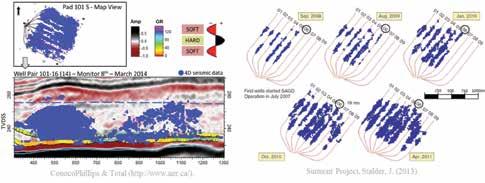
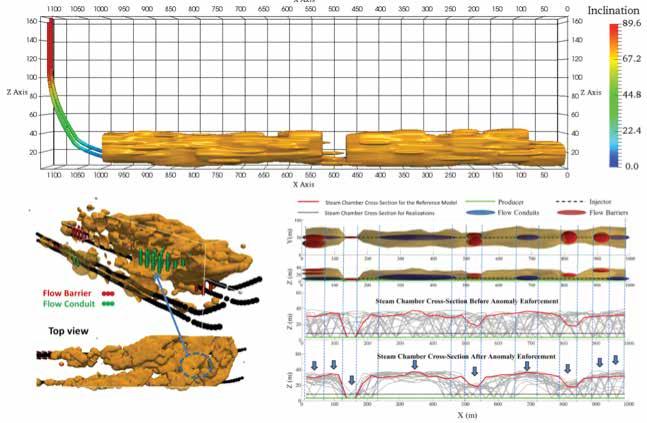
information may be best described by anomalies in fluid flow that can be inferred from the unusual patterns in variations of a seismic attribute. The proposed methodology is based on geostatistical enforcement of anomalies identified by visual inspection of 4D seismic images. This applies more constraint on the model of geological uncertainty represented by multiple geostatistical realizations of the reservoir. Modifying the facies realizations to enforce the information obtained from
4D seismic results in an improved model that honors the observed large-large scale flow patterns.
The proposed methodology is designed to respect the geological framework, input statistical parameters inferred from well data and conceptual models. This methodology benefits from human judgement to identify anomalies in fluid flow with high confidence. The initial facies realizations may be evaluated to
(Continued on page 44...)
RESERVOIR ISSUE 3 • MAY/JUNE 2017 39 DIVISION TALKS
4D seismic data used for reservoir monitoring.
4D seismic driven steam chamber, anomaly identification and geostatistical Enforcement.

assess the fidelity of anomalies and identify the missing ones in each realization. The fidelity analysis and subsequent geostatistical enforcement is automated. This methodology is a pre-/post-processing tool that can be implemented to improve different facies modeling techniques. The concept behind the proposed methodology and details of its implementation in practice are presented in this talk.
BIOGRAPHY
Mostafa Hadavand is a PhD candidate
and a research assistant at the Centre for Computational Geostatistics (CCG), University of Alberta. He joined CCG in January 2014 and is about to finish his PhD. His research interests include geological uncertainty quantification and management, reservoir characterization, data assimilation, SAGD proxy modeling and multivariate data analysis. His background is in mechanical engineering and he holds a master degree in mechanical engineering from Sharif University of Technology, Tehran, Iran.
DIVISION INFORMATION
There is no charge for the division talk and we welcome non-members of the CSPG. Please bring your lunch. For details or to present a talk in the future, please contact Weishan Ren at renws2009@gmail.com or David Garner at david@terra-mod.com

Have you been a member of the CSPG for 30+ consecutive years?
If so, watch your email inbox for your invitation to the 16 th Annual CSPG Long-Time Members Reception. Attendance is by invitation only.
Tuesday, May 9, 2017 | 4:00 pm – 6:00 pm The Fairmont Palliser Calgary
Tickets: $25 - available to purchase through www.cspg.org
40 RESERVOIR ISSUE 3 • MAY/JUNE 2017 DIVISION TALKS
Geostatistical anomaly enforcement improves facies modeling and the fidelity.
Long -Time Members Reception
CSPG HEAVY OIL / OIL SANDS TECHNICAL DIVISION TALK
Predicting heterogeneity in fluvial and tidal-fluvial meander-belt deposits:
The point bar to counter point bar transition
SPEAKER
Paul R. Durkin, University of Calgary
Time: 8:00 am
Date: Tuesday June 13th
Location: Halliburton
Training Centre (Room 1830, 645 – 7th Ave SW)
ABSTRACT
Meander-belt deposits are inherently complex in terms of stratigraphic architecture and sediment distribution. Recent research on counter-point bar deposits specifically, has highlighted their potentially significant differences in reservoir quality compared to adjacent point bar deposits. However, recognition criteria and characteristics of counterpoint bars in the ancient rock record are still relatively under-reported. In order to improve subsurface predictions of
meander-belt lithofacies, we document a series of modern point bar to counter-point bar transitions from a range of fluvial to tidalfluvial environments. A series of vibracore and sediment samples were collected along point bar to counter point bar transitions on the Willapa, Chehalis and Peace Rivers, from Washington State and Alberta. Results document a significant decrease in net-togross from the upstream convex point bar, to the downstream counter point bar. The transition is congruent with an inflection point in meander bend morphology from convex point bar to concave counter-point bar. We compare modern examples studied to a variety of subsurface and outcrop point bar to counter point bar transitions from the Alberta Foreland basin, including the Cretaceous McMurray and Grand Rapids formations. We find that the changes documented in modern meandering channels are consistent with ancient examples, and reservoir quality of IHS-
and siltstone-dominated counter-point bar deposits are significantly poorer than adjacent sandstone-dominated point bar deposits. Impact on reservoir performance and steam chamber development within stacked meander-belt successions is also considered.
BIOGRAPHY
Dr. Paul Durkin completed his B.Sc. at McMaster University, before moving to the University of Calgary to undertake a Ph.D. with Dr. Stephen Hubbard. His thesis focused on fluvial meander-belt processes, including point bar evolution, sedimentology and stratigraphic architecture, and geocellular modelling. Paul is currently a post-doctoral researcher at the University of Calgary, and has recently accepted a position as an Assistant Professor in Geological Sciences at the University of Manitoba starting in January 2018.




RESERVOIR ISSUE 3 • MAY/JUNE 2017 41 DIVISION TALKS
SPRING FORWARD CSPG Education | May 2017 VISIT WWW.CSPG.ORG/SPRINGFORWARD FOR FULL COURSE DESCRIPTIONS AND TO REGISTER TODAY! OVER 20 COURSES AND FIELD TRIPS ARE BEING OFFERED BY THE CSPG FOR SPRING FORWARD TOPICS INCLUDE: Environmental Exploration Core Heavy oil Geomechanics Geomodelling Structural Sedimentology
MEDAL OF MERIT 2016
As specified in CSPG bylaws the Canadian Society of Petroleum Geologists Medal of Merit is awarded annually for the “best paper related to Canadian petroleum geology” published during the previous publication year, in this case for peer reviewed papers published in 2015. The medal is important recognition of excellence in Canadian petroleum geoscience research and writing and has been awarded since 1952. The paper chosen this year was written by Denis Lavoie, Nicolas Pinet, Jim (James) Dietrich and Zhuoheng Chen and is entitled “The Paleozoic Hudson Bay Basin in northern Canada: New insights into hydrocarbon potential of a frontier intracratonic basin”. The paper was published in the AAPG Bulletin, Vol. 99, No. 5, p. 859-888 (May 2015).
This paper describes a regional re-evaluation of the petroleum systems potential of the Hudson Bay Basin utilizing updated datasets and analysis. The Hudson Bay Basin is the largest intracratonic basin in North America and has been generally under-explored (nine wells) due to a perception of inadequate charge.
The authors provide a detailed and thorough exploration and geologic history of the basin and systematically investigate each element of the petroleum system, with a focus on the potential source rocks and thermal maturity. Numerous observations including hydrocarbon shows from wells, petrophysical anomalies, seafloor pockmarks, oil slicks, Rock-Eval data, vitrinite reflectance and thermal models support an interpretation of a locally active source system. Additionally, the paper provides a discussion of exploration risk associated with each petroleum system element and describes five potential plays – three of which are untested.
This work is an important contribution as it provides an updated interpretation of the petroleum system potential in the largely unexplored Hudson Bay Basin. Specifically, the authors have addressed the main exploration risk with a thorough analysis of potential source intervals and have concluded hydrocarbon potential in the Hudson Bay Basin is greater than previously thought.
Biographies and Photos
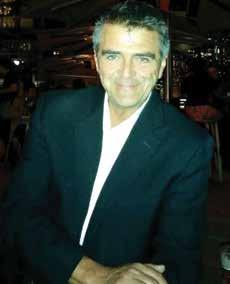
Denis Lavoie obtained a Ph.D. in sedimentary geology and geochemistry from Laval University in 1988 and Geological Survey of Canada in 1989 as a research scientist. His research focuses on sedimentary environments, organic and inorganic geochemistry as they pertain to conventional hydrocarbon systems in the Canadian North and on resource and environmental aspects of unconventional hydrocarbon systems in southern Canada. He has produced over 150 scientific papers and government reports on the geological understanding and hydrocarbon potential of Canadian Paleozoic sedimentary basins and was Editor-in-Chief of the CSPG Bulletin (2008-2012).
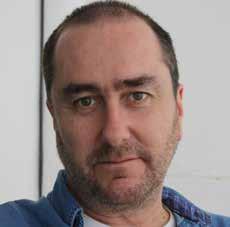
Nicolas Pinet obtained a Ph.D. in geodynamics from Nice-Sophia Antipolis (France) in 1990. After a post-doctoral fellowship in the INRS-ETE (Quebec), he was

42 RESERVOIR ISSUE 3 • MAY/JUNE 2017
SOCIETY NEWS
involved in several mining projects before joining the Geological Survey of Canada in 2005. His main interests are mountain building and basin formation mechanisms.

James Dietrich graduated from the University of Waterloo in 1977 with a BSc in Earth Sciences. His GSC research activities have included studies of seismic data and petroleum resource assessments of sedimentary basins across Canada, including the Beaufort Sea, Pacific Margin, Gulf of St. Lawrence, Hudson Bay and Arctic Canada Basin regions.
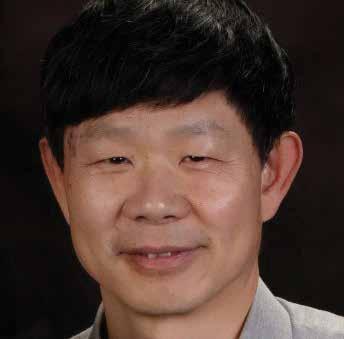
Zhuoheng Chen obtained his Ph.D. from the Norwegian University of Science and Technology in 1993 and held a position as an associate professor at China University of Petroleum (Beijing) before joining the Geological Survey of Canada in 1998. His current research interests include petroleum resource assessment for conventional and unconventional reservoirs (methods and applications), petroleum system, hydrocarbon generation kinetics and basin analysis.
2017 – 28th Annual CSPG Mixed Golf Tournament 25 August

Mark your calendars, and get ready for the 2017 CSPG Mixed Golf tournament on 25th August at Lynx Ridge Golf course. The four -golfer, best-ball tournament includes a round of golf, meals, plenty of hospitality and good times, and a chance to network with your colleagues and industry sponsors. This year we trust that we return to the typical August golf, where the course is at its finest, with the inviting fairways, smooth greens, spectacular mountains and the everbeckoning water hazards and sand traps to capture errant golf shots.
This is a fun tournament, with balanced teams that allow all golfers to contribute to the team score, while having a great time enjoying the day and the fellowship of golfing as a team, and developing your network of geoscientists.
Please watch for further announcements, registration forms and information in the CSPG Reservoir, and make sure to register on -line at the CSPG website www.cspg.org. Register early to avoid disappointment!
We thank our previous sponsors from 2016 and look forward to the return of members, guests and sponsors to enjoy the event. A big thank you to our continuing committee members, Darin Brazel, Norm Hopkins, Jeff Boissoneault, and co-chair Brenda Pearson.
You can address registration inquiries to David Middleton at 403 -296-8844 (dmiddleton@suncor.com), or to Kristy Casebeer, CSPG Coordinator at 403-513-1233 (kristy.casebeer@cspg.org).
If you are interested in sponsoring the tournament this year, please contact David at dmiddleton@suncor.com or Brenda at bpearson@birchcliffenergy.com.
David Middleton & Brenda Pearson Co-Chairs CSPG Mixed Golf Tournament
RESERVOIR ISSUE 3 • MAY/JUNE 2017 43 SOCIETY NEWS
RJW DOUGLAS MEDAL 2016
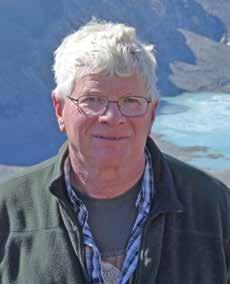
Dr. Dale Leckie is being honoured by CSPG with the 2016 RJW Douglas Medal that is presented each year for “outstanding contributions to the understanding of sedimentary geology in Canada”.
Dr. Leckie was born and brought up in north-east Alberta and attended the University of Alberta where he received his B.Sc.. Moving on to McMaster University he obtained an M.Sc. and then his Ph.D. in 1983. His doctoral dissertation on the Falher Formation of north-west Alberta and north-east British Columbia led to Dale’s life-long interest in the geology of the Cretaceous of Western Canada, for which he has become known as a world expert.
After a couple of years at Petro-Canada,
Dale joined the Geological Survey of Canada and for the next 14 years, produced seminal studies of the Mesozoic strata of Western Canada from the Liard Basin to south-west Saskatchewan. Many of these involved collaboration with industry and academia to align strong fundamental geoscience with petroleum and mineral exploration.
In 1998, Dale became Chief Geologist at Wascana Energy, later Nexen, where his interests were allowed to expand worldwide. It was at this stage in his career that his recent contributions to unlocking the mysteries of “unconventional resources” began in earnest. Both in the Oil Sands of north-east Alberta and “shale” reservoirs of Western Canada and elsewhere, Dale has and continues to make invaluable contributions to our understanding of these challenging deposits.
Dale is a true scientist; he works with fundamental data to elucidate complex geological problems and then through careful synthesis provides a thoughtful and sound interpretation. Not content to just come up with answers, Dale is a preeminent contributor to advancing geological interpretation in Canada, particularly the Cretaceous of the Western Canada Sedimentary Basin, as shown by the more than 200 technical articles, papers, posters and oral presentations to his credit. He also contributes to the geological knowledge base by editing important collections of contributions and technical journals, peer reviewing works by other contributors
and doggedly encouraging his fellow geoscientists to present their work to the geological community.
For his outstanding contributions to the understanding of sedimentary geology in Canada, the CSPG is delighted to present Dr. Dale Leckie with the 2016 RJW Douglas Medal.

44 RESERVOIR ISSUE 3 • MAY/JUNE 2017
SOCIETY NEWS
LINK AWARD – BEST ORAL PRESENTATION
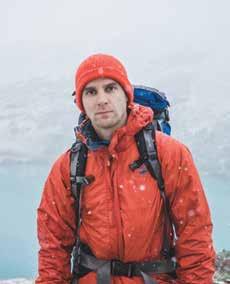
CSPG’s Link Award is given for the best oral presentation at one of the Society's Technical Luncheons. The 2015-16 recipient of Link Award is Dr. Dallin Laycock for his presentation "Muddy Clinoforms and the Influence of Aggregated Mud Clasts".
Dallin received his Bachelor of Science in Geology from Brigham Young University in 2009, and Ph.D. from the University of Calgary in 2014. He currently works for ConocoPhillips in Calgary.
While at BYU, he co-authored a book designed to educate the public about the geology of Utah’s national parks. To date this book has sold over 50,000 copies, and is
one of the best-selling items in the National Park visitor centers. During his time at the University of Calgary, Dallin’s research on mudstone stratigraphy and sedimentology earned him the University of Calgary’s Eyes High Research Award in 2012, Best Student Oral Presentation at the 2013 CSPG Convention, as well as the 2014 CSPG award for Best Ph.D. Thesis.
The award will be presented at the CSPG Awards Ceremony held during the CSPG Geoscience Conference in May 2017.
UNIVERSITY OUTREACH Thank-You from the 2016 Atlantic Universities Geoscience Conference
By Erin Anderson
I would like to extend my sincere thanks to the Canadian Society of Petroleum Geologists for sponsoring the CSPG award at the 2016 Atlantic Universities Geoscience Conference (AUGC). I was honoured to receive the award this year for a presentation of my undergraduate thesis work titled: “Diagenetic effects and fluid flow along erosional boundaries in the Triassic Wolfville Formation at Rainy Cove, Nova Scotia”. I am completing my honours thesis this year under the supervision of Dr. Grant Wach at Dalhousie University.
My work is focused on fluvial sandstones in the Bay of Fundy. The fluvial sequences make up part of the Wolfville Formation, which is the reservoir component of a potential hydrocarbon system in the Fundy Rift Basin. This work can be applied to studies in the Bay of Fundy and to similar fluvial systems in rift settings.
The AUGC is a student-organized conference that gives undergraduates
the opportunity to present their work in a formal context. The presentations are well attended by the Atlantic geoscience community and industry representatives, who provide valuable feedback for these early stage research projects. To further understanding of local geology, the conference hosts field trips and seminars for participants and welcomes a keynote speaker at the final banquet. The CSPG’s involvement in this conference and support of undergraduate students is exemplary. I am very grateful for the award and look forward to continuing my research this year.
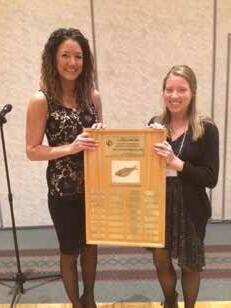
RESERVOIR ISSUE 3 • MAY/JUNE 2017 45 SOCIETY NEWS
UNIVERSITY OUTREACH
CSPG at WIUGC 2017: Students Look for Outlook on Petroleum Industry, Networking, Volunteering Opportunities
By Ryan Baker, Crew Energy, University Outreach Committee
This year marked the 53rd annual Western Inter-University Geosciences Conference (WIUGC) hosted at the Delta Hotel and Conference Center in Edmonton, Alberta. A total of 180 undergraduate and graduate students attended the four day conference along with forty-nine professional volunteers. The conference included a number of events including short courses and field trips, industry talks, student presentations and awards, and even a dodgeball tournament. Overall, there were sixteen technical talks, one keynote speaker, and one distinguished lecturer whose talk was open to the public on the Friday evening. The conference wrapped up with an industry networking mixer and keynote banquet. The University Outreach Committee represented the CSPG with a booth at this year’s industry networking event and mixer.
During the first two days of the conference students were able to attend short courses, a mentorship panel, and student project presentations. The student presentations were adjudicated and the winners were named at the final keynote banquet. The recipient of the CSPG Presentation Award was Brendon Lybbert (undergraduate)
for “Sedimentology and Petrology of the Cardium “B” Sandstone, Caroline Area, Alberta, Canada”. The top oral presentations were given by Daniel Calvo Gonzalez and Ben Lysak. The recipients of the Poster Presentation Awards were Daniel Calvo Gonzalez and Jessica Zerb. The technical talks were well attended and feedback from attendees indicate Oil Sands, Space Geology, Ichnology, and Renewable Energy were well received, popular topics.
The CSPG University Outreach Committee was present at the conference for the networking event mixer. As one of eight booths at the mixer, many students stopped by to inquire about the CSPG. A number of swag items distributed were extremely popular including the Geologic Roadmap of Alberta as well as CSPG branded T-shirts and measuring tapes. Speaking with students at the mixer, many were concerned about scarcity of job prospects in the oil and gas industry as a result of the industry downturn. Conversations with undergraduates nearing program completion revealed many felt the need to pursue graduate studies in geoscience in the face of limited job opportunities.
Many undergraduate and graduate students visiting the booth were keen on volunteering and networking through the CSPG. Many students inquired about the possibility of more opportunities arising outside of Calgary. Feedback from students attending universities outside of Alberta indicated a strong interest in more involvement with the CSPG, however they felt the majority of opportunities were in Calgary.
Another fantastic take-away from interactions at this year’s booth was the number of students educated about scholarship opportunities the CSPG has to offer. In addition to inquiries around volunteering, networking, and job prospects, students were very interested in scholarship information. A number of visitors to the booth were not familiar with the CSPG and the benefits of student membership. The CSPG presence at the conference was well received by students and recent graduates. Hopefully those that were previously unaware of the benefits offered by the CSPG left more informed about the society.
46 RESERVOIR ISSUE 3 • MAY/JUNE 2017 SOCIETY NEWS


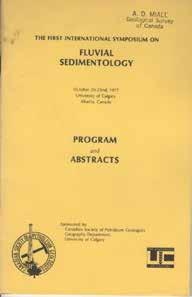

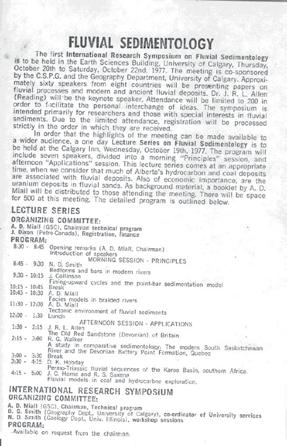
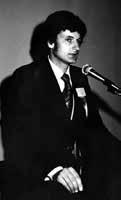
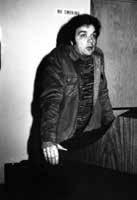
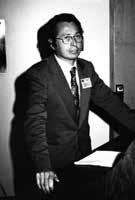
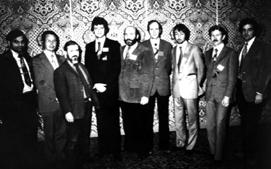 Andrew Miall
The below pictures were taken at the "Fluvial Lecture Series" that we arranged for industry people in what is now the Westin Hotel, before the conference itself.
Norm Smith John Allen
Ram Saxena, John Allen, Roger Walker, Andrew Miall, John Horne, David Hobday, John Collinson, Jim Dixon, Norm Smith, from left to right.
Andrew Miall
The below pictures were taken at the "Fluvial Lecture Series" that we arranged for industry people in what is now the Westin Hotel, before the conference itself.
Norm Smith John Allen
Ram Saxena, John Allen, Roger Walker, Andrew Miall, John Horne, David Hobday, John Collinson, Jim Dixon, Norm Smith, from left to right.

2017 Mountjoy Conference – Mountjoy II
June 26-29 in Austin, Texas at the UT Learning Commons and Austin Core Research Center, Austin, TX, USA
Sponsored by SEPM (Society for Sedimentary Geology) and CSPG (Canadian Society of Petroleum Geologists)
Technical Sessions – oral and poster that address the overall theme of the ConferenceCarbonatePoreSystems
Sedimentological, Stratigraphic, and Diagenetic Controls on Development of Carbonate Pore Systems
Microporosity in Conventional and Unconventional Carbonate Reservoirs
Multiscale Prediction and Upscaling of Carbonate Porosity and Permeability
Interactions in Multi-Modal Pore Systems
Visualization, Quantification, and Modeling of Carbonate Pore Systems and Their Fluid Flow Behavior
Field Trips - Included in the Conference fee is a choice of 1-day field trips - details on the registration website. Participants may choose one from the following four trips until a trip is full:
Albian-Age Pipe Creek Rudist Build -Ups and Impact of Touching and Non -Touching Vugs on Reservoir Characterization Leader is Laura Zahm | Statoil
Fractures and Pores within Evaporite Paleokarst Systems: An Example from the Cretaceous of Texas – Leader is Chris Zahm | BEG University of Texas
Fractures, Faults, and Karst Caverns: Architecture of the Non -Matrix Reservoir Elements – Leader is Bob Loucks | BEG University of Texas
Fault Zone Deformation and Displacement Partitioning in Mechanically Layered Carbonates: The Hidden Valley Fault, Central Texas – Leaders are David Ferrill, Alan Morris and Ronald McGinnis | Southwest Research Institute
Core Workshop - included in registration fee, at the Austin Core Research Center (CRC) with cores representing a spectrum of geologic time and depositional setting s, as well as unique diagenetic environments
Field Trips - Optional Pre- and post-Conference - at additional cost - details at the registration site.
Pre-conference trip: Upper Cambrian Microbial Mounds in Central Texas – Leaders are Andre Droxler | Rice University, Paul (Mitch) Harris| University of Miami / Rice University, and Bill Morgan | Morgan Consulting
Post-conference trip: Classic Outcrop Exposures of the Permian Guadalupe Mountains – Leaders are Charles Kerans | University of Texas, Chris Zahm | BEG University of Texas, and Paul (Mitch) Harris | University of Miami / Rice University
Plan to join us for this timely and substantial Conference. Please contact any of the meeting organizers below with questions.
General Chair - Paul (Mitch) Harris (pmitchharris@gmail.com)
Oral and Poster Sessions - Don McNeill (dmcneill@rsmas.miami.edu) and Gene Rankey (grankey@ku.edu)
Core Workshop - Laura Zahm (LAZ@statoil.com)
Field Trips - Astrid Arts (Astrid.Arts@cenovus.com) and Chris Zahm (chris.zahm@beg.utexas.edu)
Social Events - Jean Hsieh (jhsieh@repsol.com)
Additional Sponsors

Shell











































































































 Andrew Miall
The below pictures were taken at the "Fluvial Lecture Series" that we arranged for industry people in what is now the Westin Hotel, before the conference itself.
Norm Smith John Allen
Ram Saxena, John Allen, Roger Walker, Andrew Miall, John Horne, David Hobday, John Collinson, Jim Dixon, Norm Smith, from left to right.
Andrew Miall
The below pictures were taken at the "Fluvial Lecture Series" that we arranged for industry people in what is now the Westin Hotel, before the conference itself.
Norm Smith John Allen
Ram Saxena, John Allen, Roger Walker, Andrew Miall, John Horne, David Hobday, John Collinson, Jim Dixon, Norm Smith, from left to right.
